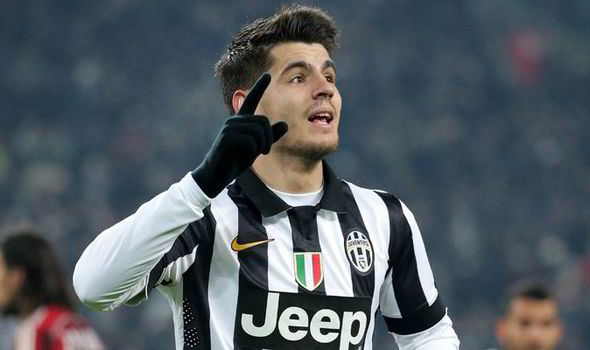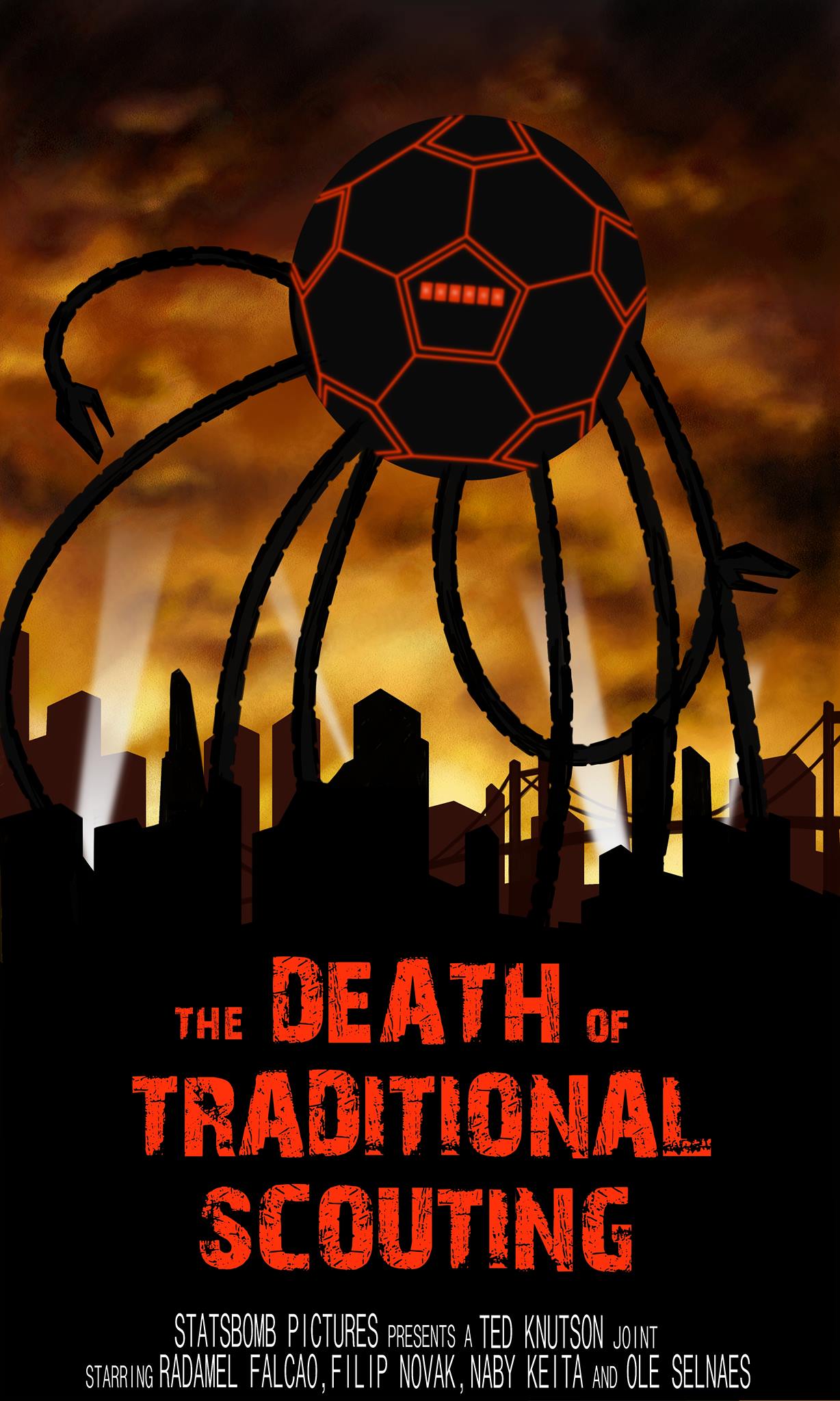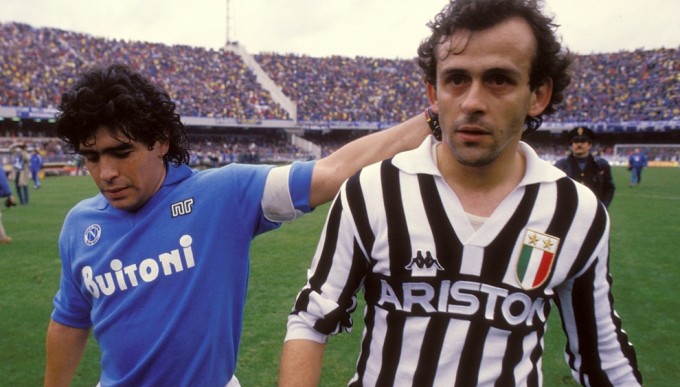 The Old Lady comeback The 2015/2016 edition of Serie A had an unforeseen start and a wacky development, but still ended in the most predictable way, with pre-season favourites of Juventus clinching their 5th Scudetto in a row with 2 games to go. Allegri’s team had their worst start in history, collecting just 5 points in their first 6 games (1W-2D-3L, 6GF-7GA), and they were already considered doomed by most of the media and the public. While Juve continued to struggle accumulating a meagre 12 points tally after 10 games, four other teams led the league outright, a record for Serie A: in chronological order Inter, Fiorentina, Roma and Napoli. However an unprecedented run in which the Bianconeri won 25 games out 26 (leaving behind them just 2 points after a 0-0 draw in Bologna), started on Halloween and lasted until match-day 37, when Juventus, already crowned champions, lost 2-1 to already relegated Hellas Verona. In the roller-coaster that was Juve’s season, shot conversion played an huge role. In the first 10 games of the season, Juventus converted just 6.7% of their chances, but their scoring rate almost trebled in the following 28 games, reaching an extraordinary 16.8%. At the same time the 13.5% conversion rate against they endured until match day 10, dropped to a hard to believe 3.7%. It’s therefore understandable that during this streak of games, Gianluigi Buffon broke Sebastiano Rossi’s Serie A record of 929 minutes without conceding a goal, pushing it to 973 minutes unbeaten.
The Old Lady comeback The 2015/2016 edition of Serie A had an unforeseen start and a wacky development, but still ended in the most predictable way, with pre-season favourites of Juventus clinching their 5th Scudetto in a row with 2 games to go. Allegri’s team had their worst start in history, collecting just 5 points in their first 6 games (1W-2D-3L, 6GF-7GA), and they were already considered doomed by most of the media and the public. While Juve continued to struggle accumulating a meagre 12 points tally after 10 games, four other teams led the league outright, a record for Serie A: in chronological order Inter, Fiorentina, Roma and Napoli. However an unprecedented run in which the Bianconeri won 25 games out 26 (leaving behind them just 2 points after a 0-0 draw in Bologna), started on Halloween and lasted until match-day 37, when Juventus, already crowned champions, lost 2-1 to already relegated Hellas Verona. In the roller-coaster that was Juve’s season, shot conversion played an huge role. In the first 10 games of the season, Juventus converted just 6.7% of their chances, but their scoring rate almost trebled in the following 28 games, reaching an extraordinary 16.8%. At the same time the 13.5% conversion rate against they endured until match day 10, dropped to a hard to believe 3.7%. It’s therefore understandable that during this streak of games, Gianluigi Buffon broke Sebastiano Rossi’s Serie A record of 929 minutes without conceding a goal, pushing it to 973 minutes unbeaten. 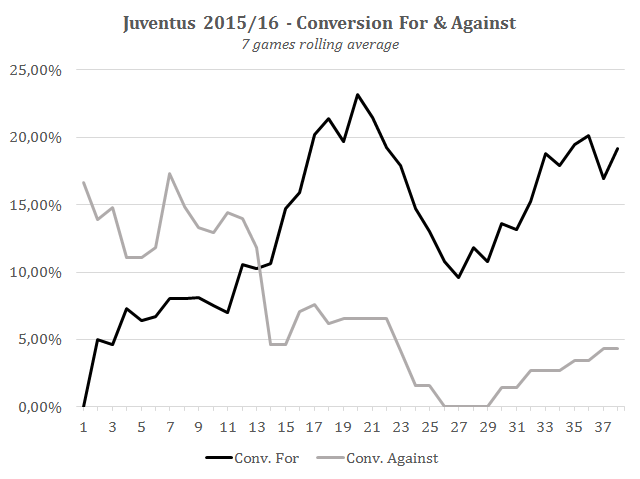 It’s true that Juventus’ come back coincided with Buffon and Evra’s notorious scolding of the locker room in Reggio Emilia, but also the Bianconeri somewhat managed to remedy to their below expectations start by greatly overperforming in the final two thirds of the season. Luck probably played a part too, but the reason behind the level of their performances can be explained by the gap which persists between Juventus and the rest of the league, even after the departures of Pirlo, Vidal, Llorente and Tevez. The credit for this success surely belongs to Max Allegri, but once again the wise picks in the transfer market by Director General Giuseppe Marotta and Sporting Director Fabio Paratici played a big part in their victory. Those four players scored 54% of Juve goals in all competitions between 2013/2014 and 2014/2015 but this season new-comers actually had a greater impact, scoring 48 of the 75 of the Old Lady's Serie A goals (64%), with Dybala recording the best scoring contribution per 90 (1.02) since their comeback to the Serie A in 2007.
It’s true that Juventus’ come back coincided with Buffon and Evra’s notorious scolding of the locker room in Reggio Emilia, but also the Bianconeri somewhat managed to remedy to their below expectations start by greatly overperforming in the final two thirds of the season. Luck probably played a part too, but the reason behind the level of their performances can be explained by the gap which persists between Juventus and the rest of the league, even after the departures of Pirlo, Vidal, Llorente and Tevez. The credit for this success surely belongs to Max Allegri, but once again the wise picks in the transfer market by Director General Giuseppe Marotta and Sporting Director Fabio Paratici played a big part in their victory. Those four players scored 54% of Juve goals in all competitions between 2013/2014 and 2014/2015 but this season new-comers actually had a greater impact, scoring 48 of the 75 of the Old Lady's Serie A goals (64%), with Dybala recording the best scoring contribution per 90 (1.02) since their comeback to the Serie A in 2007.  The Gold of Naples – Maurizio Sarri e Gonzalo Higuaín In their two-faceted season, Juve had the edge over any other Serie A team in terms of shots for (599) and against (340) and subsequently in TSR (63.8%) and SoTR (69.4%). Actually all teams but one: Napoli. The team of newly appointed manager Maurizio Sarri, topped the Bianconeri in all these categories, except shots against, since they conceded four shots more (344): the Partenopei recorded a 65.6% TSR and a 73.4% SoTR, and if we look at their shots on target differential, their 4.08 +/- is the second best ever recorded in the Serie A between 2006/2007 and 2015/2016. Only Juventus in 2011/2012 did better in this regard.
The Gold of Naples – Maurizio Sarri e Gonzalo Higuaín In their two-faceted season, Juve had the edge over any other Serie A team in terms of shots for (599) and against (340) and subsequently in TSR (63.8%) and SoTR (69.4%). Actually all teams but one: Napoli. The team of newly appointed manager Maurizio Sarri, topped the Bianconeri in all these categories, except shots against, since they conceded four shots more (344): the Partenopei recorded a 65.6% TSR and a 73.4% SoTR, and if we look at their shots on target differential, their 4.08 +/- is the second best ever recorded in the Serie A between 2006/2007 and 2015/2016. Only Juventus in 2011/2012 did better in this regard. 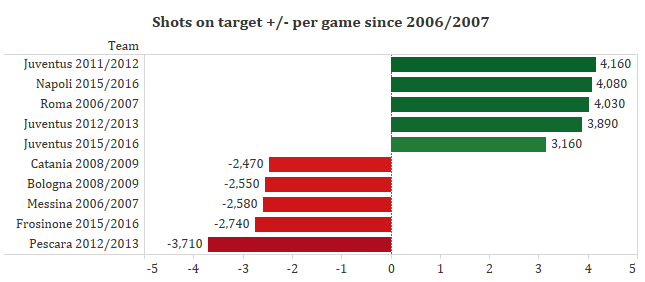 Napoli broke the club record for most points collected (82) and most goals scored (80) in a single Serie A season and they led the league alone for 7 games, something that happened last during the Maradona-era in 1989/1990. With the San Paolo stadium as their fortress, the Azzurri were unbeaten at home this season (16 W, 3D) a feat shared with only Borussia Dortmund in Europe's top 5 leagues. If we look at game-state, Napoli were the Serie A team which trailed the least amount of minutes (327) a huge improvement in comparison to last season, when Benítez’ team spent 910 minutes behind. Given this statistic it’s not surprising that Napoli were also the team who improved their points tally the most in comparison with the previous year (+19). Sarri essentially improved the team in every aspect, granting them a true shot at the title, but they lacked Juve’s depth, since their top 11 regulars played a draining 88 percent of possible minutes versus the 68 per cent played by the 11 Bianconeri players with the most minutes played.
Napoli broke the club record for most points collected (82) and most goals scored (80) in a single Serie A season and they led the league alone for 7 games, something that happened last during the Maradona-era in 1989/1990. With the San Paolo stadium as their fortress, the Azzurri were unbeaten at home this season (16 W, 3D) a feat shared with only Borussia Dortmund in Europe's top 5 leagues. If we look at game-state, Napoli were the Serie A team which trailed the least amount of minutes (327) a huge improvement in comparison to last season, when Benítez’ team spent 910 minutes behind. Given this statistic it’s not surprising that Napoli were also the team who improved their points tally the most in comparison with the previous year (+19). Sarri essentially improved the team in every aspect, granting them a true shot at the title, but they lacked Juve’s depth, since their top 11 regulars played a draining 88 percent of possible minutes versus the 68 per cent played by the 11 Bianconeri players with the most minutes played. 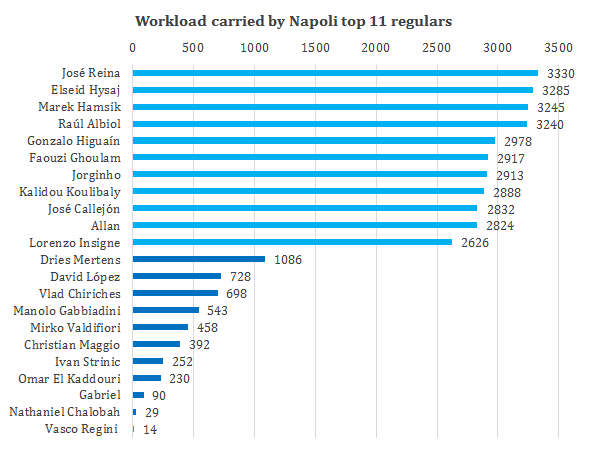 Their (almost) historical performance benefited from an individual historical performance: Gonzalo Higuaín (5.50 shots and 1.00 non-penalty goals per 90) scored 36 goals, beating the 66-years-old Serie A all-time record of goals scored in a single season, overcoming Gunnar Nordhal, who scored 35 times in 1949/1950. https://www.youtube.com/watch?v=mR1QSxhJ7ik Higuaín 36th goal of the season was probably the best of the lot. If they manage to keep El Pipita and enlarge their roster via the transfer market, Napoli will surely contend once again for the Scudetto next season. The resurgence of Roma under Luciano Spalletti Roma were one of the five teams which led the league alone this season, but the crisis they suffered at the end of 2015 saw their Scudetto hopes vanishing and ultimately led to the sacking of Rudi Garcia. The club signed ex-manager Luciano Spalletti, who previously sat on the Giallorrossi’s bench between 2005 and 2009, and Roma experienced a true resurgence that allowed them to secure their third consecutive Champions League qualification. Only Juve achieved more points than Roma in the second half of the season: under the Tuscan manager Roma collected 46 out of 57 available (14 W, 4 D, 1 L) and improved in every stat I looked at.
Their (almost) historical performance benefited from an individual historical performance: Gonzalo Higuaín (5.50 shots and 1.00 non-penalty goals per 90) scored 36 goals, beating the 66-years-old Serie A all-time record of goals scored in a single season, overcoming Gunnar Nordhal, who scored 35 times in 1949/1950. https://www.youtube.com/watch?v=mR1QSxhJ7ik Higuaín 36th goal of the season was probably the best of the lot. If they manage to keep El Pipita and enlarge their roster via the transfer market, Napoli will surely contend once again for the Scudetto next season. The resurgence of Roma under Luciano Spalletti Roma were one of the five teams which led the league alone this season, but the crisis they suffered at the end of 2015 saw their Scudetto hopes vanishing and ultimately led to the sacking of Rudi Garcia. The club signed ex-manager Luciano Spalletti, who previously sat on the Giallorrossi’s bench between 2005 and 2009, and Roma experienced a true resurgence that allowed them to secure their third consecutive Champions League qualification. Only Juve achieved more points than Roma in the second half of the season: under the Tuscan manager Roma collected 46 out of 57 available (14 W, 4 D, 1 L) and improved in every stat I looked at. 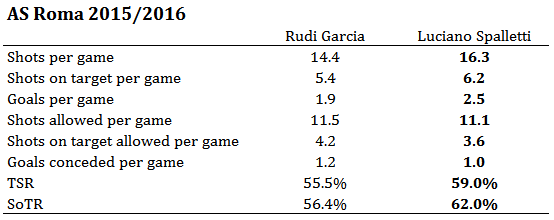 But Spalletti wasn’t the only newcomer who influenced Roma’s improved performance from January onwards: Sporting Director Walter Sabatini got Diego Perotti from Genoa and Stephan El Shaarawy from AC Milan (via Monaco), two players who were instrumental in the second part of the Giallorossi's season. In his six months in Rome, Perotti’s contributed with a league best 0.52 assists, 0.22 non-penalty goals and 3.36 successful dribbles per 90 minutes, while “the Pharaoh” was the top scorer in Serie A (8) after being transferred during the January window. El Shaarawy had 3.77 shots and 0.60 non-penalty goals per 90 in the 1202 minutes he played with Roma, which will definitely activate his reported € 13 M redeem option. The two, together with ex Chelsea and Fiorentina winger Mohamed Salah, who scored 9 goals and recorded 6 assists in the final 19 games of the season, formed Roma's “Fast & Furious” offensive trio, balancing out Edin Dzeko’s poor season in front of the goal: in fact according to various expected goals models, the Bosnian striker underperformed his xG of around 40%. Indeed Dzeko converted his 3.73 non-penalty shots per 90 minutes at a low rate of 7.41%, averaging just 0.28 non-penalty goals. Roma are one of the few analytical thinking clubs in Italy, with their analytical department currently being improved, and it will be very interesting to see what they will decide to do with their striker, considering also Spalletti's pivotal role in transfer decisions and the little signs of decline he already showed in his numbers during his last season at Manchester City. Dzeko was basically the only Roma player who experienced finishing woes this season, since Roma led the league in all shot conversion rate, scoring 14.2% of their shots, a figure way ahead of the 9.8% league average. In this scenario, Miralem Pjanić set a personal record for both goals (10) and assists (12), while Radja Nainggolan also beat his record of goals in a season, with all his 6 goals scored under Spalletti. Roma still has room for improvement, and the next transfer session will be a delicate one: they will probably lose one or two key players because they need to rack up some money to stabilize their financial situation and to pay for their first two Brazilian signings of the summer, with Alisson (€ 7 M) and Gérson (€ 17 M) both joining the Giallorossi this summer. The collapse of the two earliest leaders: Inter and Fiorentina Inter regression to the mean was possibly the easiest thing to see happening in the entire 2015/2016 season and in my Serie A half-season review I wrote about them performing like a mid-table team while sitting in 3rd. After 19 games, Samir Handanović had saved the 85.5% of the shots on target he had faced and a drop in the second part of the season seemed inevitable: as expected, by the end of the season his save rate had fallen to 72.2%. In fact he maintained just 3 clean sheets in the second half of the season, while he had 12 in the first part, which outlines well the range of their regression. Their TSR (7th) and SoTR (7th) ranks remained pretty much the same, because the rise in their shots per game, from 12.0 to a much more solid 15.1, had been countered by an increase in shots allowed per game, from 11.1 to 13.4. Despite this improvement in their offensive production, Inter scored just 50 goals: no team in Europe top 5 leagues won 20 games scoring so infrequently. Fiorentina's drop in points per game (from 2.00 to 1.37) was more difficult to predict, but there were some alarm bells. First of all, as I wrote in the half-season review, 8 penalties scored was a rate unlikely to sustain in the second part of the season, even if I didn’t expect they would be awarded just a single penalty, that they missed, in the last 19 games of the Serie A. The second and most worrying sign was the high percentage of shots attempted from outside the box: a mix of a lack of penetration and a couple of trigger-happy shooters (like Iličič, 2.71 shots from outside the box per 90, and Zarate, 2.97) resulted in 54% of their shots attempted from outside the box. This trend was confirmed by Michael Caley’s xG numbers which have them 8th in total xG for, despite being 3rd in the league for total shots for. An aspect in which they surely have to improve is defending corner kicks: they conceded a league worst 17% of their goals from a corner (7 out of 42). All in all, we can’t consider Fiorentina's season disappointing, since they recorded their 5th top 5 in five seasons (in the past four seasons they finished 4th) with a squad which in my opinion was worse than last season and a positive balance in the transfer market. The January window was particularly poorly planned, with decisions clearly not agreed together with head coach Paulo Sousa: Zarate, Tello, Tino Costa, Koné and the injured Benalouane played just 2069 minutes combined. Sassuolo in the Europa League Sassuolo had to wait until the end of the Coppa Italia, in which Juve beat Milan after extra time, to celebrate their first ever European qualification. Milan would’ve gone into Europe had they won the final, but with Juventus already in the Champions League, the European spot instead goes to the Emilian side, who finished 6th in Serie A. In just their third (consecutive) Serie A season, the Neroverdi have qualified for Europe, after the 12th place of last season and the 17th of their first ever Serie A season.
But Spalletti wasn’t the only newcomer who influenced Roma’s improved performance from January onwards: Sporting Director Walter Sabatini got Diego Perotti from Genoa and Stephan El Shaarawy from AC Milan (via Monaco), two players who were instrumental in the second part of the Giallorossi's season. In his six months in Rome, Perotti’s contributed with a league best 0.52 assists, 0.22 non-penalty goals and 3.36 successful dribbles per 90 minutes, while “the Pharaoh” was the top scorer in Serie A (8) after being transferred during the January window. El Shaarawy had 3.77 shots and 0.60 non-penalty goals per 90 in the 1202 minutes he played with Roma, which will definitely activate his reported € 13 M redeem option. The two, together with ex Chelsea and Fiorentina winger Mohamed Salah, who scored 9 goals and recorded 6 assists in the final 19 games of the season, formed Roma's “Fast & Furious” offensive trio, balancing out Edin Dzeko’s poor season in front of the goal: in fact according to various expected goals models, the Bosnian striker underperformed his xG of around 40%. Indeed Dzeko converted his 3.73 non-penalty shots per 90 minutes at a low rate of 7.41%, averaging just 0.28 non-penalty goals. Roma are one of the few analytical thinking clubs in Italy, with their analytical department currently being improved, and it will be very interesting to see what they will decide to do with their striker, considering also Spalletti's pivotal role in transfer decisions and the little signs of decline he already showed in his numbers during his last season at Manchester City. Dzeko was basically the only Roma player who experienced finishing woes this season, since Roma led the league in all shot conversion rate, scoring 14.2% of their shots, a figure way ahead of the 9.8% league average. In this scenario, Miralem Pjanić set a personal record for both goals (10) and assists (12), while Radja Nainggolan also beat his record of goals in a season, with all his 6 goals scored under Spalletti. Roma still has room for improvement, and the next transfer session will be a delicate one: they will probably lose one or two key players because they need to rack up some money to stabilize their financial situation and to pay for their first two Brazilian signings of the summer, with Alisson (€ 7 M) and Gérson (€ 17 M) both joining the Giallorossi this summer. The collapse of the two earliest leaders: Inter and Fiorentina Inter regression to the mean was possibly the easiest thing to see happening in the entire 2015/2016 season and in my Serie A half-season review I wrote about them performing like a mid-table team while sitting in 3rd. After 19 games, Samir Handanović had saved the 85.5% of the shots on target he had faced and a drop in the second part of the season seemed inevitable: as expected, by the end of the season his save rate had fallen to 72.2%. In fact he maintained just 3 clean sheets in the second half of the season, while he had 12 in the first part, which outlines well the range of their regression. Their TSR (7th) and SoTR (7th) ranks remained pretty much the same, because the rise in their shots per game, from 12.0 to a much more solid 15.1, had been countered by an increase in shots allowed per game, from 11.1 to 13.4. Despite this improvement in their offensive production, Inter scored just 50 goals: no team in Europe top 5 leagues won 20 games scoring so infrequently. Fiorentina's drop in points per game (from 2.00 to 1.37) was more difficult to predict, but there were some alarm bells. First of all, as I wrote in the half-season review, 8 penalties scored was a rate unlikely to sustain in the second part of the season, even if I didn’t expect they would be awarded just a single penalty, that they missed, in the last 19 games of the Serie A. The second and most worrying sign was the high percentage of shots attempted from outside the box: a mix of a lack of penetration and a couple of trigger-happy shooters (like Iličič, 2.71 shots from outside the box per 90, and Zarate, 2.97) resulted in 54% of their shots attempted from outside the box. This trend was confirmed by Michael Caley’s xG numbers which have them 8th in total xG for, despite being 3rd in the league for total shots for. An aspect in which they surely have to improve is defending corner kicks: they conceded a league worst 17% of their goals from a corner (7 out of 42). All in all, we can’t consider Fiorentina's season disappointing, since they recorded their 5th top 5 in five seasons (in the past four seasons they finished 4th) with a squad which in my opinion was worse than last season and a positive balance in the transfer market. The January window was particularly poorly planned, with decisions clearly not agreed together with head coach Paulo Sousa: Zarate, Tello, Tino Costa, Koné and the injured Benalouane played just 2069 minutes combined. Sassuolo in the Europa League Sassuolo had to wait until the end of the Coppa Italia, in which Juve beat Milan after extra time, to celebrate their first ever European qualification. Milan would’ve gone into Europe had they won the final, but with Juventus already in the Champions League, the European spot instead goes to the Emilian side, who finished 6th in Serie A. In just their third (consecutive) Serie A season, the Neroverdi have qualified for Europe, after the 12th place of last season and the 17th of their first ever Serie A season.  Their shooting dominace had not been exceptional: their 50.7% TSR had been just the 9th best in the league, and they finished the season with the 8th best SoTR (52.2%), but they had the 4th best defence (40 goals allowed) thanks to the 4th lowest conversion rate against (8.5%). Despite their better than average save ratio, according to expected goals their performance was pretty much in line with the expectations. So how did they qualify, with a squad mostly unchanged in comparison with 2014/2015? In a season in which most of the teams which usually competes for the Europa League underperformed (Lazio, Milan, Torino) or got clearly declined (the two Genoese teams), Sassuolo had the virtue of being consistent all year (31 points in the first 19 games, 30 in the last 19). The board did not dismantle the squad, with a long term project (at least for the Serie A standard) built around an Italian core (Sassuolo fielded the most Italian players, 22) allowing Di Francesco’s to work with serenity. It would be interesting to see how the team manages European duty, but club owner Giorgio Squinzi has already promised investments in the upcoming transfermarket: “Next step is the Champions League” he said. Rest of the league AC Milan Milan's numbers were far from exceptional, but they managed to do worse than expected: TSR, SoTR and xG difference estimated them 6th, but they finished the season in 7th, missing European football for the third consecutive season. Lazio The Biancocelesti benefited hugely due to the fact they scored a league best 9 penalties. They also conceded more shots on target (153) than they fired (147) but that’s not the first thing I would look to correct prior to next season. Their first step should be lowering the volume of their crosses: they attempted 818 open play-crosses, a record in Europe's top 5 leagues, while converting just 6 of them (0.7%). Chievo Chievo got safe early, but got quite lucky this season. Not only they converted a league high 15 crosses but they were also the team which scored the most goals from outside the box: 12. Basically 27 of their 43 goals were scored in ways that are unlikely to be sustainable over a long period of time and next season they will have to find different solutions or they will struggle more: their 41.7% TSR and 42.2% SoTR are low and revealing, improvement will need to be found. Empoli Similar to Chievo, Empoli got out of trouble relatively fast, a feat that allowed them to relax a bit during the second part of the season. Considering their budget, European qualification was a feat too big to manage: they collected 30 points in the first half of the season, but just 16 in the second half. Genoa Marassi’s support played a huge role in the Rossoblu season, it is true that they collected 33 of their 46 points at home: no other team recorded a bigger difference between points collected at home and away. Only Higuaín had more non-penalty goals per 90 than Genoa’s Leonardo Pavoletti (0.66), still it wasn’t enough to convince Italy coach Antonio Conte to include him in his list for Euro 2016. Torino If we look at shooting numbers is difficult to imagine how Torino got involved in the fight to avoid relegation. A 12.3% conversion against didn’t help them for sure, and maybe their shooting dominance overrated them by the fact they spent a lot of time trailing early in the game. Atalanta Atalanta drew six games after gaining the lead: no other team did worse this season by this measure. They also set the record for the most direct red cards (6) and total red cards (14). Bologna Bologna was the worst offensive team in the league: they fired just 387 shots (10.2 per game) and scored a mere 33 goals, 20 in the first 19 games and just 13 in the last 19 . Despite their sterility, Roberto Donadoni saved them with relative ease after replacing former manager Delio Rossi. Sampdoria Sampdoria conceded 207 shots on target (only Frosinone did worse). Prior to this season, the Blucerchiati had collected 40 or less points in the 3-points per win era just twice: in both occasions they got relegated (1998/1999 and 2010/2011). Palermo The Rosaneri’s TSR (40.6%) and SoTR (37.8%) were abysmal, and they fought to avoid relegation until the very last game: at the end they got safe by a single point. Udinese In 2015/2016 Udinese set a club low for points in a 20 team championship: 39. Greek goalkeeper Orestis Karnezis was the only Serie A player to feature in every minute of the 38 games played by his team. Carpi Carpi recorded league worst possession (37.8%), completing just 320 passes on average: only Frosinone completed less passes per game. Frosinone Frosinone had the worst defence in the league with 773 shots and 73 goals conceded. Their shots differential is a new Serie A negative record in the period between 2006/2007 and 2015/2016, however just 29.6% of those shots found the target.
Their shooting dominace had not been exceptional: their 50.7% TSR had been just the 9th best in the league, and they finished the season with the 8th best SoTR (52.2%), but they had the 4th best defence (40 goals allowed) thanks to the 4th lowest conversion rate against (8.5%). Despite their better than average save ratio, according to expected goals their performance was pretty much in line with the expectations. So how did they qualify, with a squad mostly unchanged in comparison with 2014/2015? In a season in which most of the teams which usually competes for the Europa League underperformed (Lazio, Milan, Torino) or got clearly declined (the two Genoese teams), Sassuolo had the virtue of being consistent all year (31 points in the first 19 games, 30 in the last 19). The board did not dismantle the squad, with a long term project (at least for the Serie A standard) built around an Italian core (Sassuolo fielded the most Italian players, 22) allowing Di Francesco’s to work with serenity. It would be interesting to see how the team manages European duty, but club owner Giorgio Squinzi has already promised investments in the upcoming transfermarket: “Next step is the Champions League” he said. Rest of the league AC Milan Milan's numbers were far from exceptional, but they managed to do worse than expected: TSR, SoTR and xG difference estimated them 6th, but they finished the season in 7th, missing European football for the third consecutive season. Lazio The Biancocelesti benefited hugely due to the fact they scored a league best 9 penalties. They also conceded more shots on target (153) than they fired (147) but that’s not the first thing I would look to correct prior to next season. Their first step should be lowering the volume of their crosses: they attempted 818 open play-crosses, a record in Europe's top 5 leagues, while converting just 6 of them (0.7%). Chievo Chievo got safe early, but got quite lucky this season. Not only they converted a league high 15 crosses but they were also the team which scored the most goals from outside the box: 12. Basically 27 of their 43 goals were scored in ways that are unlikely to be sustainable over a long period of time and next season they will have to find different solutions or they will struggle more: their 41.7% TSR and 42.2% SoTR are low and revealing, improvement will need to be found. Empoli Similar to Chievo, Empoli got out of trouble relatively fast, a feat that allowed them to relax a bit during the second part of the season. Considering their budget, European qualification was a feat too big to manage: they collected 30 points in the first half of the season, but just 16 in the second half. Genoa Marassi’s support played a huge role in the Rossoblu season, it is true that they collected 33 of their 46 points at home: no other team recorded a bigger difference between points collected at home and away. Only Higuaín had more non-penalty goals per 90 than Genoa’s Leonardo Pavoletti (0.66), still it wasn’t enough to convince Italy coach Antonio Conte to include him in his list for Euro 2016. Torino If we look at shooting numbers is difficult to imagine how Torino got involved in the fight to avoid relegation. A 12.3% conversion against didn’t help them for sure, and maybe their shooting dominance overrated them by the fact they spent a lot of time trailing early in the game. Atalanta Atalanta drew six games after gaining the lead: no other team did worse this season by this measure. They also set the record for the most direct red cards (6) and total red cards (14). Bologna Bologna was the worst offensive team in the league: they fired just 387 shots (10.2 per game) and scored a mere 33 goals, 20 in the first 19 games and just 13 in the last 19 . Despite their sterility, Roberto Donadoni saved them with relative ease after replacing former manager Delio Rossi. Sampdoria Sampdoria conceded 207 shots on target (only Frosinone did worse). Prior to this season, the Blucerchiati had collected 40 or less points in the 3-points per win era just twice: in both occasions they got relegated (1998/1999 and 2010/2011). Palermo The Rosaneri’s TSR (40.6%) and SoTR (37.8%) were abysmal, and they fought to avoid relegation until the very last game: at the end they got safe by a single point. Udinese In 2015/2016 Udinese set a club low for points in a 20 team championship: 39. Greek goalkeeper Orestis Karnezis was the only Serie A player to feature in every minute of the 38 games played by his team. Carpi Carpi recorded league worst possession (37.8%), completing just 320 passes on average: only Frosinone completed less passes per game. Frosinone Frosinone had the worst defence in the league with 773 shots and 73 goals conceded. Their shots differential is a new Serie A negative record in the period between 2006/2007 and 2015/2016, however just 29.6% of those shots found the target. 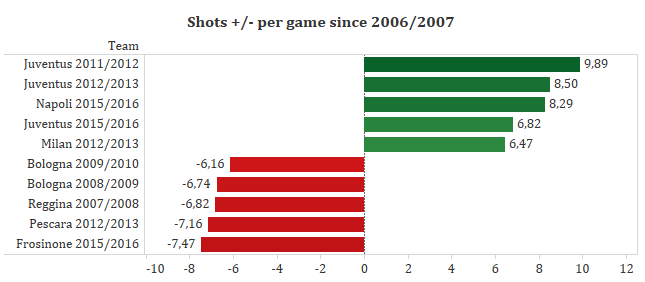 Hellas Verona Verona scored a miserable 10 open play goals this season, with their two main strikers Luca Toni and Giampaolo Pazzini, converting just the 5.55% and the 4.05% of their open-play shots. The 2015/2016 edition of the Serie A was no doubt one of the most enjoyable and unpredictable of the last few seasons. I had a lot of fun writing this final review and I hope you enjoyed it too. The Italian version of this Serie A review is available on L'Ultimo Uomo. Thanks for reading.
Hellas Verona Verona scored a miserable 10 open play goals this season, with their two main strikers Luca Toni and Giampaolo Pazzini, converting just the 5.55% and the 4.05% of their open-play shots. The 2015/2016 edition of the Serie A was no doubt one of the most enjoyable and unpredictable of the last few seasons. I had a lot of fun writing this final review and I hope you enjoyed it too. The Italian version of this Serie A review is available on L'Ultimo Uomo. Thanks for reading.
Month: May 2016
Which Way Next? 2015-16 West Ham Season Review
Remember when the goal for West Ham this season was to merely stay up in the Premier League and bank that upcoming TV money for their move to the Olympic Stadium in 2016-17? Remember how thankful West Ham were that they were knocked off in the EL qualifying playoffs to avoid distractions? Those were innocent times. Led by Slaven Bilic, the club achieved their highest point tally ever in the PL era and had their highest seeding in the table since finishing 7th in 2001-02. They set a record for both goals for and goal difference, and for little bits of time even snuck their way into Champions League conversations. They'll have to instead settle for qualification into the Europa League, but it was more than a job well done for West Ham. Go past the billions of analytical pieces on the outlier that’s been Leicester and you’ll find a couple of posts from earlier in the season about how West Ham’s start was the perfect storm of unsustainable conversions going their way and Dimitri Payet doing ridiculous stuff on a regular basis. They basically beat every traditional big team on the road to begin the season through timely scoring and parking the bus, two things that don't sustain long term. Arguably the defining “West Ham aren’t as good as where they are in the standings” post wasn’t an article, but a six minute YouTube video from Joel Salamon: Funny enough though if we divided their season into thirds, you can see a clear trend in the right direction.
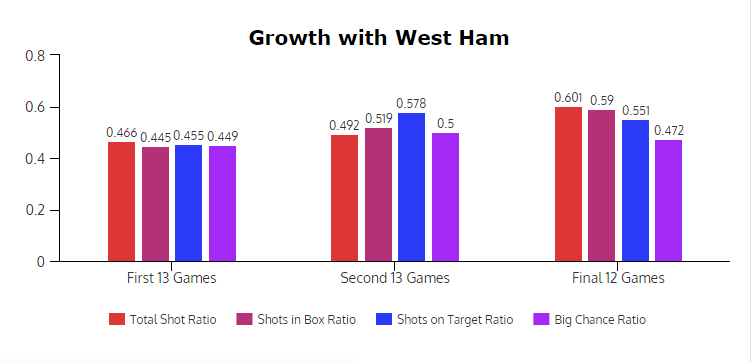
This isn’t to say that West Ham haven’t been the beneficiaries of luck, or that Joel’s analysis was wrong at the time. Far from it, it nailed a lot of good points about West Ham. They were scoring at obscene rates during the early parts of the season and even though it cooled off, they still ended up with the 18th highest goals to shot on target conversion rate in the Opta era (2009-10 onwards). Unless you’re at the level of Man City or Man United under Fergie, there’s almost no chance you are going to repeat that. However, there were good things to take from this season that have a decent chance of repeating next season. Adrian continues to look like one of the best shot stoppers in the Premier League. He had one of the best Shot Stopper ratings according to Paul Riley's xG model, and his numbers since coming into the PL have consistently been right up there. There's still many things we don't know about goalkeeping, but as the sample size has continued to increase, his level hasn't wavered much at all. Just ask Bournemouth and Liverpool what it's like to be on edge knowing your keeper is prone to giving up a howler at any time. We can't speak enough of just how good Dimitri Payet was this season. He might well have been the best set piece player in the PL this season, whether it be his audacious free kicks or setting up teammates for headers. In open play he was also remarkable as well, and all that production for £12M was great business. Now the accuracy of his free kicks will probably decline next year as they're a volatile metric, just look at what happened to Yaya Toure after his super hot 2013-14 season, but Payet's career overall has had a weird trajectory. He flirted as a disappointment through a good portion of his early years before hitting his stride in 2012-13, then 2014-15 he became one of the 3-5 best players in Ligue 1 and has continued at that level with West Ham. Perhaps he could be the type of player whose age curve is kind to him when he hits his early 30s? West Ham sure hope so, and will pay to find out if he can be somewhere close to this level for the duration of his contract. West Ham late season was very similar to the early season version of Leicester with shots and goals in abundance both ways. Overall, their matches featured on average a high 28.6 shots per game but beyond that stylistically they also share a bed with Leicester. Analysis done on Team Styles by Johannes Harkins which built on an earlier version by @SaturdayonCouch seems to lend credence to this idea:
Newly crowned champions Leicester City being grouped with West Ham is interesting as both teams have overachieved this season relative to most pre-season expectations. They profile relatively similarly across most statistics, but what sticks out for me is that both have below average possession but convert it to shots at a high rate, as reflected in their shots: possession ratio.
I don't know how long this could last as a relevant tactic even with Leicester's success, but it is clear that with how high volume their games have tended to be this season and their reliance on set piece goals, the comparisons between the two teams has merit to it. We can talk much more about West Ham's season on the pitch but perhaps the biggest thing to take from this season is in the future: they just got a brand new stadium that approaches 60,000 capacity for basically free. Seriously, that’s a thing that actually happened. Remember all the problems Arsenal had financially for like seven years after their move into the Emirates? West Ham don’t have that issue to deal with. Tottenham are facing similar issues with their new stadium being constructed. This is such a big game changer that in a few years time could assist their transformation into one of the bigger clubs in the league and given the riches abound, maybe even Europe. I say could because Newcastle offer the cautionary tale of a team with a big stadium and the size that should merit being a huge brand, but a lack of organizational sturdiness that has failed to take advantage of their resources. It's really one of two paths West Ham can take: become the new Newcastle, or join Tottenham and Liverpool in the "All we need is one mistake from the traditional top 4 to sneak into the CL" club. A lot of credit for West Ham's success has gone down to Slaven Bilic, especially considering how languid the second half of last season was under Sam Allardyce. This year, West Ham were a team that spent loads of time ahead, ranking 7th in time spent in a winning position with 1073 minutes. For reference, the league average this season was 845. It's no secret that when teams are ahead, they tend up to give up more shots and generally lose more territory, it's the basis of what stats people call "score effects". West Ham suffered more than most with this, with their shot numbers ranking below the league average in this scenario. They conceded more territory and it decreased their overall numbers because they were actually solid when the game was tied. All their shot numbers when in a draw scenario were in the top 3-5, the type of spot you want to occupy if making the CL is the goal. So Moe, do you think Bilic is a good manager after all that mumbo jumbo you went on about? *insert shrug emoticon* I mean I'm not going to say that he's a bad manager, and it's impressive that all of West Ham's underlying numbers rose throughout the season while doing stuff like playing Michail Antonio more and using the "lump it up to Andy Carroll and let him wreck havoc" card when needed, but it's just one season and if we're being honest, just being competent after replacing Sam Allardyce can make you look better in comparison. It will be interesting to see what West Ham do this summer with all the economic power they've garnered, seeing as they have some rather glaring holes to address. The center midfield rotation leaves something to be desired while the carousel of strikers they've got is kind of average. Diafra Sakho is the best of the bunch and is pretty decent but I'm skeptical he's the type of striker you want if you're truly challenging for a CL spot. Andy Carroll is what he is, and this season is probably the best he's played since that half season with Newcastle in 2010-11. The rumor mill has linked them to the likes of Michy Batshuayi and Alexandre Lacazette before Lacazette + Lyon rejected their advances. Putting my Ligue 1 fan boy hat on, a combination of Michy Batshuayi and Idrissa Gueye this summer would do West Ham wonders for next season and beyond. Batshuayi had a really productive season for Marseille despite playing with a below average supporting cast. He's only 22 and he's got the athletic build to fit into an up tempo attack. A striker core of Batshuayi/Sakho/Carroll would more than hold its own with the other big clubs vying for the higher spots. As high volume tackling central midfielders, there have been numerous comparisons between Gueye and N'Golo Kante, which is easy to do when you look at them. Both came from Ligue 1 last summer, have basic statistics that resemble each other and one of them has been relegated to the 2nd division while the other has been praised to the moon for starring in the most unlikely English champions in decades. I don't think Gueye is quite as good as Kante in terms of creating counter attacks from his defensive actions, but even if he was it wouldn't have mattered because Aston Villa were one of the worst attacking teams in recent Premier League memory. I have a soft spot for Gueye though in general and it shouldn't really take more than say £5-6M to pry him away this summer. He's a nice player and could fit well with West Ham. Where West Ham go from here is tough to predict, they could easily catch fewer breaks and drop off into mid-table, or turn into genuine reliable European contenders. Just on the merits of this season alone though, it's been a rousing success for what they wanted to achieve. Their highest finish in over a decade, a record points tally, one of the best summer buys in Payet and some wacky exciting games which doesn't really mean anything but I'm a sucker for a team that entertains me. There's still a lot to do for them to achieve a potential ceiling as a genuine force in English football, but they're on the right track, and maybe their new stadium will host more than one qualifying leg of European football next year.
Mailbag – Updated Thoughts on Alvaro Morata, Scouting, Manager Evaluation and More
Mailbag time! Readers ask questions. I promise to answer the best of them and not make fun of the worst of them.
I also promise to answer all of these questions honestly to the best of my ability, and not to lie or misdirect people from the truth.
Mostly.

Depending on what sort of tools the people you hire bring with them, maybe a month? To some extent it depends on how quickly you get the data company to send you the data, and how much time it takes you to get it organized. As long as I can query a database, we can get work done.
If I walked into a new club tomorrow that worked with Opta data, it would be a matter of days before I could advise on recruitment and maybe a month or two before the Death Star becomes fully operational. On the other hand, any analytics department should spend at least a fraction of their time learning new things so that the value of their output always increases. The curve of starting from scratch is somewhat painful, but as long as you can be less wrong than the teams you are competing against, you have an edge.
Statistical analysis in sport is a competitive endeavour and you will never, ever be smart enough.
Cost is a hella-tricky one right now, and I can tell you this out of personal experience. Part of this is because all of this is new, and football is still confused about the value of the role.
- A performance analyst role is probably £20-30k on average.
- Data analysts are not the same as performance analysts.
- A top data scientist is well into six figures as a base salary in the corporate world. Add some experience to that and you get serious money. (Well, serious for normal people, not for footballers.)
- Good data people in football should be able to save you millions of pounds a year in the transfer market
- Smart data people in football should also be able to generate goals on the pitch, provided they are listened to and integrated as part of your process.
- A single Premier League goal probably equates to £2M next season.
Now consider the fact that in American sports, estimated average salary for General Managers is $2M, depending on sport. (General Manager = Director of Football or "People who can use data to make smarter decisions")
And there’s a pretty strong argument that the good GMs are vastly underpaid. (Read this from Benjamin Morris to explain why.)
Tricky, eh?
If you are willing to hire smart kids right out of school and deal with the mistakes and learning curve alluded to above, you can probably staff a full department for £150k plus data costs. If you want more experience - and there just plain aren’t many people who have experience in stats and have worked in football right now - multiply that by a lot, but you should still get huge value.

For those who are unaware, Kevin de Bruyne is one of my favorite players in the world and has been since his first Bundesliga stint at Werder Bremen back in 12-13. When I first started writing about statistical transfers in summer 2013, I suggested him as a cheeky option as a wide attacker for Arsenal, and then thought Chelsea sold him to Wolfsburg for 50% less than they should have. Also two of my three kids are gingers, so “Ginger Freak” is a very affectionate nickname.
Obviously I am still totally in love with the Ginger Freak. He’s one of the best players in the world in transition and this season you can see him learning to become a better player in and around the box. Thinking about what he could become under Pep’s tutelage is the kind of thing that will make City games only air after the watershed next year.
Sorry kids, mature audiences only.

Britain has a fairly huge “manager” problem right now. Tactically, the country was backwards for a very long time, especially in the lower leagues. The style of football many of the current 40-60 year old coaches learned is not a great style for the modern game. Thus you are seeing more and more coaches from other countries imported into the Premier League and Championship.
Are they smarter? I don’t know, but for whatever reason, they certainly seem to have had a better football education.
I have a lot of ideas about how to find and educate better coaches – so many that I can’t fit a reasonable answer here. I have also been interacting with smart young coaches a lot in the last year, and I think the next generation of coaches here in the UK will be much more modern and forward-thinking.
If I were a young coach in England right now, I would aggressively try to find internships under coaches that are tactically innovative, because that will give you and edge in the future and the country needs that. You need to learn what they have to teach you, and you need to see how they train those tactics in sessions on the pitch.
If I couldn’t find helpful internships in England, then I would go to Germany or Spain to learn instead.
Coaching is a knowledge-based occupation. If you were going to university, you would seek out the best possible place to teach you. You need to do that with football too, it’s just that instead of a centuries-old university system, you get the chaos and disorder of modern football.
Good luck!

Rico Henry from Walsall.
English. 18 years old.
League One team of the season.
Left footed.
Plays Left Back.
Zoom zoom.

For those who have never heard of it, Smartodds is my former employer, and is owned by the same person who owns Brentford and Midtjylland football clubs. The team I was part of sat inside the company, but worked primarily for the clubs – a bit like City Football Group does for Manchester City and their sister clubs in New York, Melbourne, and Japan.
The first project I worked on for Smartodds was probably the most valuable thing I will ever create in football, and I never would have worked on that unless Matthew Benham asked me to do so. It also made me realize how much space exists in football for smart people to innovate.
If you are a team and you want to know what that project was, you can hire me to explain the details. My contact info is at the bottom.
Beyond that, it was fascinating to learn just how hard it is to get transfer deals across the line. Even when you find players early and are the first club to show an interest in a player, and everything looks great the entire time, so many transfers just do not work out.
The other big lesson is that even when you exist in a place surrounded by smart people, plenty of mistakes will be made. It’s part of life, it’s part of science, and it’s part of football.
Learn the lessons and do better next time. It’s so fucking vanilla and self-help it’s almost painful to type, but it’s the truth so there you go.

In terms of recruitment, analytics creates a bigger multiplier in lower leagues but in real monetary value, just avoiding mistakes in the top leagues is strictly worth more.
To explain: The majority of individual transfers in the top half of the Premier League this season will cost more than what Brentford paid for their entire squad. A team can buy a lot of guys for £500k and sell them on later for £2.5M. You can’t buy a lot of guys for £10M and flip them for £50M though – there just aren’t enough £50M buyers out there (or likely £50M talents).
My team at Smartodds was probably one of the few in the world that did extensive work on transfer evaluations from small and medium leagues throughout the world. Most of the teams that have analysts working on recruitment are in the Champions League and don’t need to look that far down the ladder to find talent. Because we had one of the smallest budgets in the league, we did and we learned a lot because of it.
Number of Championship clubs that have talked to me so far this year about recruitment or anything else: 1.
Seems like plenty of teams are missing some tricks right now.
With regard to everything else stats dorks can do in opposition scouting, style of play, etc, the value is probably equal across leagues, but the competition is worse at the lower levels, so it should be easier to win disproportionately more there on a small budget.

Tell me what you see on the pitch. What’s the first touch like? How does the player evaluate game situations? What mistakes are being made? What took your breath away, even if it didn’t quite work out? We have a scouting template that highlights the important stuff we want to know, so evaluate that.
Don’t worry about what the stats might have missed. If you explain the football you are seeing in front of you, that stuff should come out anyway.

I thought Morata had an excellent season last year. Adjusting to a new league can be tough, and his performance was still exceptional for a young forward.
On the surface, this season has not gone quite as well, but I’m not sure I agree. Scoring contribution per90 in the league this season was .80. Last year was .88. There no noticeable difference in output except last season he had more goals and this year he had more assists.
He also had 2 goals and 2 assists in 534 Champions League minutes against tough teams, including this piece of filth at Manchester City.
And yet worries (and the narrative) persist. The question you start to ask is why might this season be different than all the others? Stats won’t really tell you the answer to that, so I’d watch every match and compare it to previous years. What’s going on behind the scenes as well? For the numbers being batted around now, teams need to do all their due diligence, almost regardless of whether they think this year was better or worse than Morata’s past.
I thought he was huge value back when he moved to Juventus in 2014. He’ll probably move for silly money this summer and the value will be gone. That said, if I was looking for a guy to lead my line, score goals, and create goals for his teammates as a center forward for the next four years, he’d still probably be it.
For what it’s worth, I still believe Memphis has a reasonable chance to be great as well, but I’m not certain that’s possible under LVG. Football is complicated. So are humans. Memphis only turned 22 in February. Stick him with a head coach that actually wants his forwards to attack and we’ll have a better idea of whether my evaluation was terrible.

There are a myriad of ways to profile head coaches/managers with data and find more objective ways to evaluate them than just the performance on the pitch. It’s actually one of the more valuable services an analytics team can provide to clubs, and there are consultancies out there that quietly do this too.
The big thing to take away from it is whether a particular coach fits the style of play your club wants to play and/or how your personnel might fit into their new style of play. If you have to bin half your squad simply by hiring a new head coach, maybe you want to look a bit closer at some other coaches whose style doesn’t require quite so much immediate, expensive change.
No one writes about it though, because it can be a bit boring and readers seem to care not at fucking all.
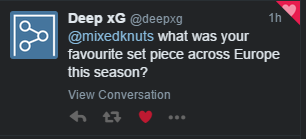
*awkward silence*
*clears throat*
Set pieces and their results are random. You might as well ask me about my favorite drop of rain.
*walks out of press conference*
*stops*
Fine, one last question.
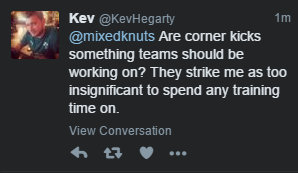
Eggggzactly. And on that note, I am out of here...
--Ted Knutson @mixedknuts mixedknuts@gmail.com
POSTSCRIPT

2015-16 Olympique Lyon Season Review
The common joke about Ligue 1 is that instead of asking "who will win the title", it's more so "how many points will PSG win the league by". As it turns out, PSG can win the league by a crap ton. But if you rewind it back to late July, there were the faint whispers that Lyon could be the team that pushed PSG for the majority of the season, kind of in a similar way to what Napoli did for Juventus. I was a bit skeptical of that happening seeing as quite a few things had to break in Lyon's favor last season for Ligue 1 to be as competitive as it was, and they benefitted from conversion luck especially in the 2nd half of the season.
But even then, I wasn't expecting Lyon to capitulate in the first 19 games to the same degree that they did. They were quite frankly... average. They were 9th in the league table with a goal difference of 0, 25 points behind PSG. The same Lyon team that were tipped to at least give PSG a bit of a fight domestically were behind such big clubs like Lorient, Caen, and newly promoted Angers. They were terrible in the Champions League despite making a big fuss about how getting back into the competition allowed them to spend more than they had in numerous years.
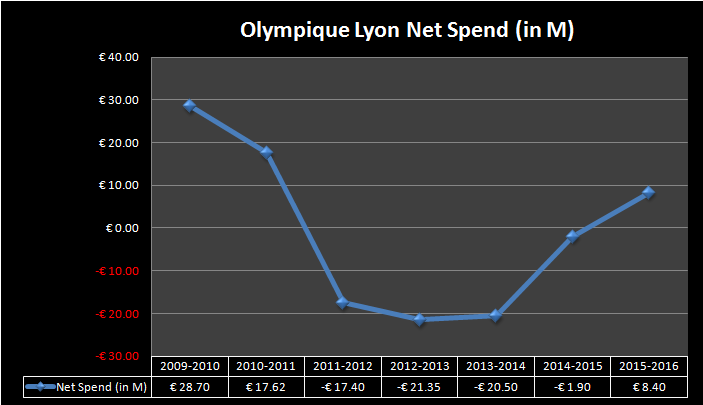
Their spending as well came into question. Mathieu Valbuena's fit was always awkward from the start, a set piece specialist who relied on crosses to create his high volume of chances was always going to have problems fitting in with a team that doesn't rely on crosses. Claudio Beauvue never really fitted in well when they played him alongside Alexandre Lacazette in a front 2 and his conversion rate dropping by over 12% from 20.5% last season to 7.8% also didn't help things. Sergi Darder was still getting used to Lyon while it seemed like Mapou Yanga-Mbiwa was committing an error at center back every other week.
It also didn't help that they were stricken by injury to their prized striker duo. Nabil Fekir tearing his ACL at the time he did (after scoring an audacious hat trick against Caen and looking like an elite young talent) put even more pressure on Lacazette to deliver and considering that Lacazette was dealing with back issues over the first couple of months, it was a recipe for disaster. It panned out that way: shorn of elite talent, Lyon played meekly in the beginning of the season.
And then boom, 5 months later and all those problems kind of just went away. Lyon have been a dominant team ever since the winter break. Their goal difference at +24 is the 2nd highest in Ligue 1, 14 more than the third highest in Lille. Their first 19 games this season have barely resembled the last 19:
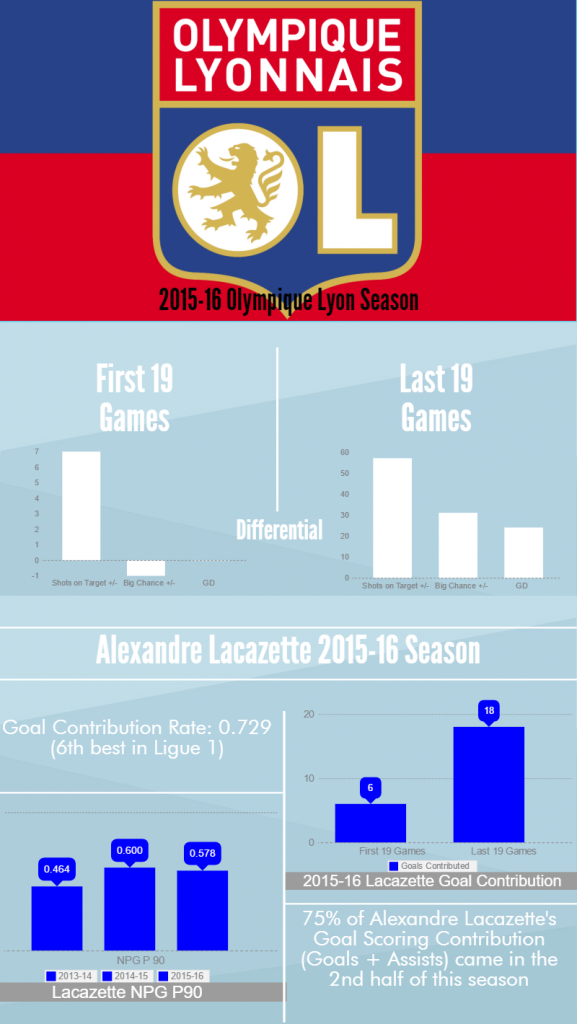
Remember when Lyon were challenging for the title last year and they were a couple of points behind Marseille after 19 games last season? Well this stretch of games has arguably been even more dominant than that one.
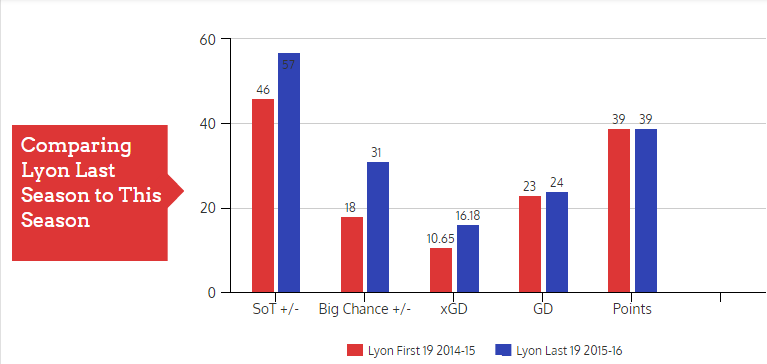
What's triggered the explosion for Lyon in the second half has been the return of form for Alexandre Lacazette. I mentioned him earlier this season and the issues surrounding his outlier performance last season, but it can be argued that Lacazette has now had his best ever season and he went on a torrid hot streak. The same can be said for both him and the likes of Rachid Ghezzal and Maxwell Cornet. Lyon ditched the 4-4-2 diamond formation that brought them all their success last season and eventually ended up with those three as their forwards in a permanent 4-3-3.
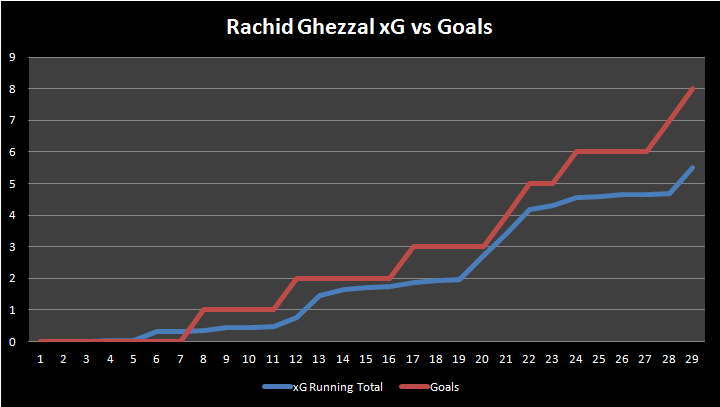
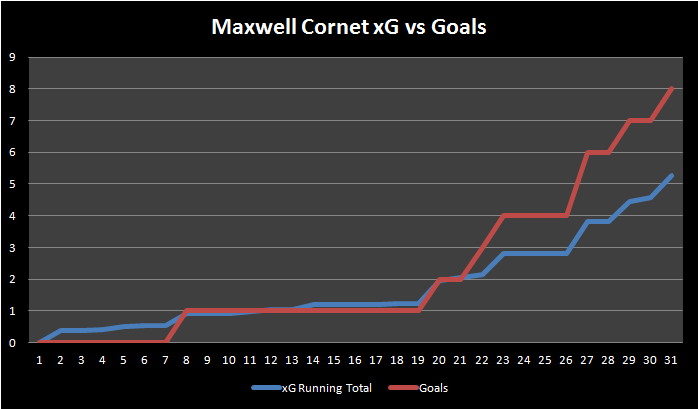
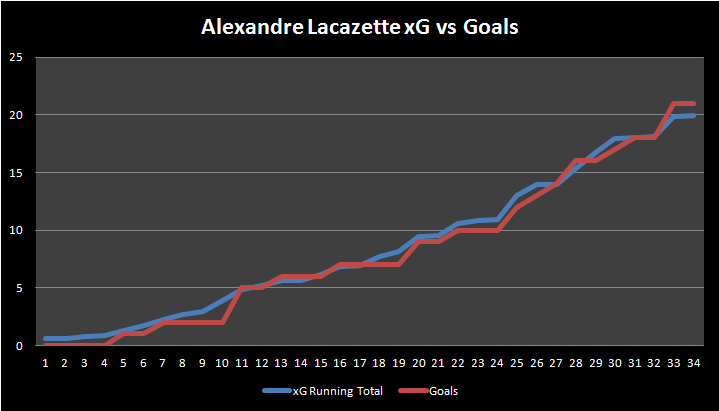
So this season has been... I'm not sure if success is the right word to use considering that they're a billion points behind PSG, but getting back to the CL group stages once again will mean that it hasn't been a failure. Their second half form in particular has been so dominant that it's almost wiped the foul stench of the first 19 games. The type of performances in particular at home were exhilarating. They were the first team to ruin PSG's bid for an undefeated season, they walked over Guingamp 5-1, they beat Monaco 6-1 to clinch an automatic birth in the CL group stages. Some of the best football in France this season have occurred in Lyon's new stadium, Parc Olympique Lyonnais.
Another good thing for Lyon going forward is that domestic competition from teams around their level might be on the decline as well. Monaco have had a disappointing season; last summer's approach of just buying a bunch of youngsters and hoping for the best hasn't produced the greatest of results so far. They do have a bigger budget than Lyon but still have more holes to fill. Nice and Rennes have had solid seasons but Hatem Ben Arfa is leaving on a free at season's end while Rennes are selling their prized young talent Ousmane Dembele to Dortmund. Saint Etienne over the past few years have never proved that they've had enough talent to be a serious enough Champions League hopeful while Marseille are in for a long rebuild unless things drastically change. Sure PSG are still there and with all their money they'll always have a big cushion over everyone else, but even they might be staring at some retooling with Zlatan leaving this summer.
This isn't to say that it's all rosy for Lyon. There have been numerous rumors about Lacazette's interest in coming to England and even though Lyon will be in the CL next season, those rumors won't stop during the summer. Nabil Fekir is still working his way back to his peak form and the faint scent of rumors for their prized centre back, Samuel Umtiti persist. It's also not a good look when they spent as much as they did for Valbuena and their best stretch has involved him being nowhere near the starting lineup. Despite how good they've been this season, this is a rather small squad and it showed early on when they had to juggle both European and domestic football.
For all that, Ligue 1 desperately needs another decent team in Europe very soon and Lyon is France's best chance at it. They have the stadium to bring in the revenue they've desired for since the project began nearly a decade ago, this will be their second straight season with Champions League football to entice players to come over and they have a great academy that in particular has been able to produce attacking talent. From the likes of Karim Benzema, Anthony Martial, Alassane Plea and now recently with Fekir and Aldo Kalulu. Again, look at everyone else in comparison and Lyon by far are in a more steady place. It's a far cry from the dark days of 2012-14 when the club had to sell players and solely rely on their academy just to keep itself functional.
Lyon have a lot to look forward to in the near future. Admittedly some of this will depend on whether they can keep Lacazette going forward and if not, what will their contingency plan be. The likes of Cornet, Fekir and Kalulu mean that Lyon at least have the basis for a decent attack if they sell Lacazette and just stick in house. Nobody knows if Bruno Genesio is truly Lyon's manager of the future, I mean hell at this time last season it looked like Lyon had their manager in Hubert Fournier and that bubble burst by December. But at the very least he's overseen Lyon's dominant 2nd half of the season and appears to have pointed them in the right direction.
Four months ago if you asked whether Lyon had a shot of just being in the Champions League next season, the majority of people would've been hugely skeptical. Now, Ligue 1 has a potential for a 2nd above average continental team in Lyon. If this version can remain in place for next season, then both Ligue 1 and Lyon will be in a much better place going forward.
Didn't Work Out: The Premier League's Worst Transfers 2015-16
Nobody is suggesting that player recruitment is a simple task. A team could sign a budding star player but if he misses mum’s home cooking and craves a simpler life, it’s unlikely he will stick around and help you win the league. Sometimes personalities or cultures clash or key decision makers just aren’t too great at their jobs. Maybe a manager is vetoing signings while trying to bring in his old mate’s son, or an agent has got friendly with the chairman. However we look at it, aspects of football’s transfer market are ripe for manipulation and inefficiency is rife.
Should it be this way? Not really, but when money and glory and sport intersect, often times folly is not too far behind. Here with a hefty dose of hindsight put through a blender of logic is a look at the 2015-16 Premier League signings that for whatever reason, either made no sense or just haven’t worked. If nothing else we should be able to identify a few risk factors and ideas of how not to waste the vast Premier League bounty that burns a hole in every chairman's pocket. This list doesn't include all possible options, you no doubt will have ideas of others, but for impact, bad planning and expense, it covers many sins.
After we'll look at a couple of players that will likely land on other similar lists with reasons why really, the jury is still out.
Christian Benteke
Liverpool finished 2014-15 with a 6-1 defeat at Stoke City and started without a striker. Rickie Lambert emerged from the bench, but with Brendan Rodgers choosing to play a 4-3-3, fluidity seemed to be the primary style in play, for all that it didn’t work.. Mario Balotelli was out of favour and soon to leave, Daniel Sturridge injured and further striking options were clearly necessary for 2015-16. In came Danny Ings while Divock Origi returned from loan. So far, sensible. But there seem to have been twin forces working at Anfield since the FSG takeover and last summer was no different. The easy to like signing of Roberto Firmino--he had the numbers--has over time looked well worth his fee, especially when contrasted with the square peg that is Christian Benteke.
Benteke’s stats are fine, he has averaged around half a goal per game in his first season at Liverpool, precisely what he averaged in his last season at Aston Villa and broadly, he is a reliable mid-volume shooter, so what’s the problem? In all likelihood, Benteke’s signing was the folly of a manager clinging to his post and to be deemed successful, he was likely to have been expected to create greater output. There were immediate concerns that he wouldn’t fit Rodgers’ system, that were loudly amplified as Jurgen Klopp continually selected others instead.
Benteke hasn’t failed, but the selection process that deemed him a viable signing broke down somewhere and he was never the right fit. Who signed off on the deal? Still a more than capable goalscorer, lower placed Premier League teams should have him top of their summer shopping lists and with a loss sure to be made £15m might get the conversation started.
Gökhan Inler and Yohan Benalouane
As much as anything Inler and Benalouane are good examples that even when your recruitment team is as feted as Leicester City’s is, you can still get things very wrong. Inler arrived as a well respected veteran of eight seasons in Serie A and over 80 international caps. A fee of £5m was mooted for a player who at 31 was clearly on the wrong end of the age curve and one might presume that the whole endeavour was an attempt to replicate the successful Esteban Cambiasso experiment. Leicester’s solid and unchanging first eleven has proved unaccommodating for the Swiss star and 195 league minutes in three starts and two substitute appearances reflect how minimal his impact has been that he has been called upon from the bench so sparingly could reflect a lack of trust from coach Claudio Ranieri. Deemed a coup upon signing it must also be presumed that he commands a decent wage but a three year deal for a 31 year old? Ouch...
Even less successful was Benalouane. Signed for a similar fee, he played just 66 substitute minutes and somehow managed to undershoot the team’s already low pass completion rate in completing just 4 of 14 passes before departing for Fiorentina on loan. It is to be hoped that his contract is not lucrative as it is reported to be for four years.
All clubs will miss with transfers and its should be remembered that Jamie Vardy, Riyad Mahrez and N'Golo Kanté arrived over a series of transfer windows; they weren't a one hit magic spell of uncovered gold. A team that puts more into it's recruitment strategies will hopefully find more of the better players but will always run the risk of finding and overinvesting in a Benalouane or an Inler as well.
Serge Gnabry and Alex Pritchard
Military service was the stick that beat young men into shape for many years in this country and it can only be presumed that an opportunity to see cultural differences led to these two talented young players joining up with West Brom and the Tony Pulis junta. In a move that seemingly benefited nobody, Gnabry got 12 league minutes before being recalled to Arsenal in January, only to be replace by Pritchard--already toughened up from his time in the Championship at Brentford--and on the road to recovery from injury has found just 62 minutes of play.
Each signing is hard to quantify as both players lack the natural build and fortitude to be converted to centre back and now their futures look no clearer than they were at the start of the season. What was the point? Maybe only Pulis knows.
Scott Sinclair and Micah Richards
Aston Villa’s blend of Tim Sherwood and an analytics department created a two tiered summer recruitment drive that ultimately found the best of neither world. For the future, Ligue Un was liberated of Jordans, Idrissa Gueye was secured ahead of fellow suitors Leicester and Barcelona were pillaged for Adama Traoré. Every team needs to think of the long term and within a strong base of a team, these signings may well have paid off. Indeed, their futures will be interesting to follow, be they at or away from Villa Park. The general perspective is that they “weren’t good enough” but there is sufficient evidence to presume that it’s too early to make final judgements here.
The Sherwoodian side is less worthy of praise. From Emmanuel Adebayor’s rejection of the club due to advice from a pastor--who may well have correctly foretold their impending failure-- to the signing of 33 year old car enthusiast Joleon Lescott, there were elements that seemed far from on message with the rest of the recruitment arm.
Most criticism can be reserved for the unfortunate gambles on Scott Sinclair and Micah Richards. Sinclair last played anything like a full season in 2011-12 and although young enough to be deemed worthy of a four year contract, has failed to impress in 18 starts, so much so that he has been tried in nearly every attacking position in the team and has not managed to make any his own. Two goals from sixteen shots in 1500+minutes and ne’er a goal assisted from five whole shots created and all we’re left with is a phantom contribution.
For Richards it’s more of a sad tale having been long beset by injury problems, but his recruitment screams of a Sherwood gambit; you can envisage the conversation: “Helluva player was Micah, if we can just get him back to his best…” and boom, a four year contract lands in the post. He too was young enough to hope for but also hadn’t managed anything like a full season or even a half season since 2011-12. The possibility of his retained fitness seemed remote, and to his credit he has achieved that, but certainly he is not the player he was, and even a cursory review of his recent career and problems with injury would reveal that. He may well now continue his career at Villa and find the Championship more to his current level.
Steven Naismith
Norwich saved the pennies in the summer and ended up spending the pounds in January. Did they spend them wisely? It seems more likely that blowing £8m plus wages on a three and a half year deal for a 29 year old squad man from a mid table Premier League club was a sub-par allocation of resources.
One goal and a shade over one shot a game suggests that Naismith might not have been the saviour Norwich’s misfiring attack were wishing for, and what may be a standard Premier League contract will look quite expensive if as seems likely they return to the Championship.
Radamel Falcao, Alexandre Pato et al
Chelsea have had some delightful talents in their squad over the years but the loan signings of Falcao and Pato have felt more like a case of buying museum piece cars-- 2010 vintage-- to keep in the garage and occasionally marvel at. With two league starts and under 400 minutes between the pair over around 14 months of generous wages, it becomes puzzling to ascertain the purpose of signing multiply injured former talents.
Chelsea have found a diverse level to their recruitment this last year and the entirely logical and smart signings of Diego Costa and Cesc Fabregas now look more a blip among a series of more unfathomable choices. Pedro gets a free pass as at least he had recent credentials but nobody knows why they signed Michael Hector, a player who may be a reasonable gamble for a lower half Premier League team but who seems incongruous in among the elite. Papy Djilobodji came from so far out of left field that he might as well have been sitting in the stands with a hot dog and a beer and has already joined the loan army.
Plenty of young players have arrived or been reintegrated, Baba Rahman, Matt Miazga, Kenedy and Bertrand Traore to name but four, but with a huge season of transition coming, Chelsea need to accelerate their future into the present and their recent transfer record is decidedly mixed.
Newcastle: team award
When you spend the best part of £80m over two transfer windows on seven 20 to 25 year olds and look like getting relegated, it’s probably worth conducting a quick review of your processes. Newcastle have had obvious weaknesses for years, at centre back Fabricio Coloccini at 34 is long past his best-- note how many relegated teams have past it centre backs, it’s a theme--and pairing him with Chancel Mbemba was a baptism of fire for the younger man. They have also posted a seriously sub-par save percentage for four years yet haven’t seen fit to get into the market and buy a new bone fide first choice goalkeeper. These are the major holes in the squad so what did Newcastle do to solve it? They bought attackers, lots of them.
First the positive: players that still have enough value that other teams may want to purchase them in the future. Andros Townsend, given a run of games for the first time in years has done well and Georginio Wijnaldum at least looks talented but Aleksandar Mitrovic is the only one player on the team to have created any kind of shot volume this year and in contrast, the miss list won’t look pretty playing Championship football next season.
That same miss list might not seem so damaging were Newcastle not in the business of giving out abnormally long contracts in an attempt to maximise the resale value of their investments. Henri Saivet has more years on his contract (five and a half) than league appearances (four) and Florian Thauvin has already returned to France with a five year deal in his back pocket. Beyond this, Seydou Doumbia, thankfully just a loan signing, has managed just 29 minutes of league football. His failing at Roma and now near absence for Newcastle poses a question we will return to about Russian League form.
Newcastle’s strategy has long seemed scattergun, but only this season have they sunk significant investment into their signings-- and it hasn’t worked.
Jury’s out
The pitfalls of writing this kind of article were highlighted to me in the research stage when I chanced upon a Telegraph article from January highlighting 20 “flop” Premier League transfers. A few names from here featured but the starkest member of the list was Roberto Firmino. While it took time for the former Hoffenheim man to settle, that he would now easily be considered for a signing of the season list shows that patience and acclimatisation are often requisite for expensive signings, maybe moreso if coming from a different league or with a language barrier to overcome. As someone who has followed Erik Lamela’s career up and down through rose tinted glasses, it's a situation I know well. Hence for these two, the jury remains out:
Oumar Niasse
It remains to be seen if the signing of Oumar Niasse is the last big folly of the old regime or the first mistake of the new Farhad Moshiri era. Maybe that’s harsh on a player that had work permit issues, a wrist problem and a lack of match practice but thus far he hasn’t looked like £13m well spent. Two shots in his two starts and 142 total minutes is a far cry from the lethal striking seen at his former clubs and Everton must hope that the often difficult transition from the Russian Premier League to the English version can be successfully negotiated long term. He was a four shot a game man in Russia and contributed to over a goal per 90 minutes played and must have impressed key influencers at the club to have secured such a lucrative move. With any large fee comes a long contract, this time four and a half years, but in a team that has far more problems at the other end of the pitch, it seemed strange to use up so much of their budget on another striker, and especially mid-season.
But really, it’s too soon to call him an absolute flop. With a reasonable chance that Romelu Lukaku could leave in the summer, pre-purchasing a replacement may end up smart and your view on the likelihood of success may well rely on how highly you rate the standard of the Russian League and the risks associated with taking statistics there at face value. Only Salomón Rondón seems to have escaped the recent curse of the transferred Russian League goal machine, managing eight goals for a Tony Pulis team is more than reasonable. In order to get an idea of what type of player Niasse is I took the liberty of joining the scouting ranks-- I cued up a couple of Youtube videos. A lot of his goals appeared to involve his breaking free of unset defences, with plenty of space around him. How well will he be able to perform in a more defensively robust league where space and chances are harder to find? Signs of settling will be required quickly next year, or else his time on Merseyside may well be short.
Memphis Depay
With every goal that Anthony Martial scores, it appears that Memphis Depay becomes further away from the spotlight he was expected to occupy upon joining Manchester United last summer. A statistical outlier in Holland, a rare mega shot provider (over five per game), some concerns were raised around his shot selection, but he looked a genuine goal talent in his final year at PSV and sure to progress.
And maybe he will, for although the goals have dried up and his coach appears to have lost faith in him, he has still provided a solid shot volume (around 3.5 per 90) and at 22 years old has a ton of time to find out how to play in a bigger league. Possibly that leap from Holland to England has been more difficult than expected and it is well documented how Louis van Gaal’s systems limit a player’s shooting volume. Whether he stays at the club or is deemed (unwisely) to be surplus to requirements, it is more likely than not that the best of Memphis Depay will be forthcoming and found somewhere, long term. He may not end up the next Ronaldo, but he sure won't end up a bust either.
_________________________________________________
Thanks for reading.
Find me on twitter at @jair1970
Manchester United: The Fallen Keep Falling
No one quite knows what is going to happen at the world’s biggest club this summer. What was supposed to be a season where United returned to glory looks a lot more like a dumpster fire of missed opportunity.
With performance at the top of the league as weak as it has ever been, it’s shocking to find United once again likely to miss out on Champions League play. The question is why? Is it van Gaal’s fault? Are the players not good enough? Is there a brain cloud over Manchester affecting the entire city’s footballing performance? Let’s find out!
Facts
- Transfermarkt estimates United have a net spend on transfers of £150M the last two seasons. I suspect this underestimates the Martial deal and includes flipping Angel di Maria to PSG for a loss, but it's a big number however you slice it.
- Combine that with nearly £60M spent the year after Sir Alex retired and you are looking at well over £200M invested into the playing squad the last three years, two of which were clearly guided by Louis van Gaal's requirements.
- United’s payroll is monstrous, though so too are their commercial revenues. They can get away with paying high wages, even to declining performers like Wayne Rooney.
In terms of quality, the recruitment has actually been pretty good. Shaw’s injury was bad luck, but Blind, Herrera, Shaw, di Maria, Martial, Memphis, and Schneiderlin are all excellent players. Schweinsteiger was always going to be an occasional guest star because his body was breaking down well before he left Germany, but he’s a classic “winning mentality” guy and a genuine leader.
So yeah, I don’t hate the recruitment aside from the prices paid, but if any team in the world can afford to spend to much on good transfers, it’s Manchester United.
And yet… this is actually difficult to believe but...
Manchester United are generating 11.3 shots a game.
That’s bad.
Actually, it’s putrid.
The only teams who create fewer chances a game are the three teams that are probably getting relegated plus attacking powerhouses West Brom Albion and Stoke.
Let me put this a different way…
BIG SAM’S TEAM TAKES MORE SHOTS A GAME THAN MANCHESTER UNITED.
Over £200M in net spend, can’t create more shots than Sunderland.
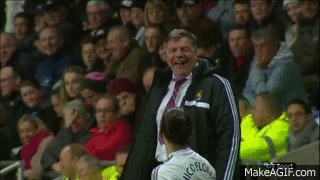
We can talk about shot quality all you want, but LVG’s United are taking 50% fewer shots than the elite teams in the league. That might be a problem if you want to compete for CL spots, let alone win a title.
Yes, the defense has been good, but there's a bit of luck involved. Okay fine, some say "luck", others say "the otherworldly skills of David de Gea." Either way, the tradeoffs for keeping the defense sound is making eunuchs out of all the attackers. That’s a huge systemic flaw, and the blame for it can’t be pointed anywhere else except van Gaal.
To illustrate the drop-off a little more clearly, I’ve taken shot maps from the last Fergie season and put them next to what United have done in 37 league matches this year for comparison.
Let’s start with the defense.
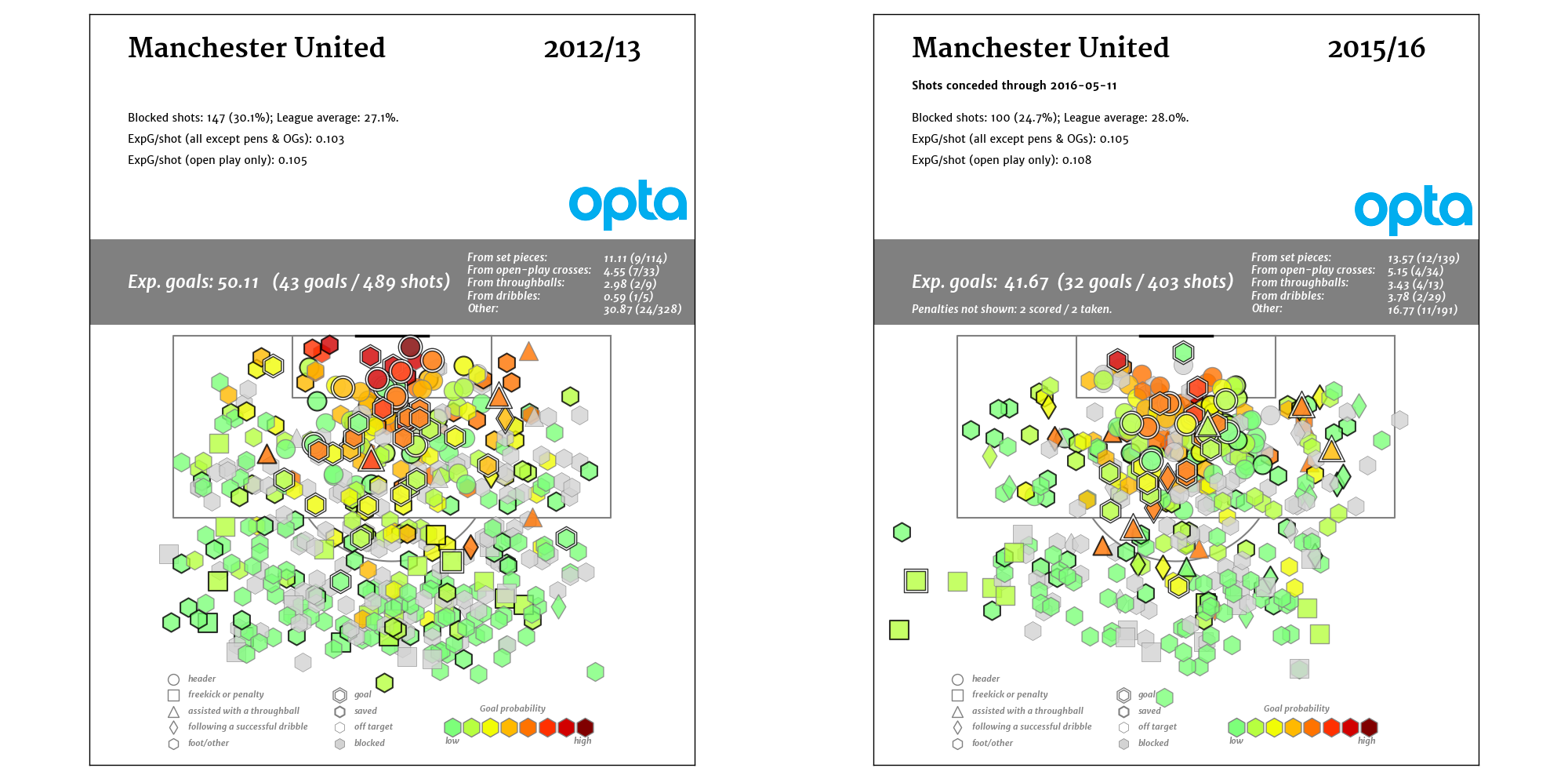
(Click to embiggen)
Despite giving up 20 shots to West Ham on Tuesday, LVG’s team this year will concede somewhere between 15 and 20% fewer shots than the last Fergie team. The quality of shot conceded is a fraction higher, while they block 5% fewer. So Fergie’s United gave up more volume in defense but the rest is a bit of a wash.
Now for the attack…
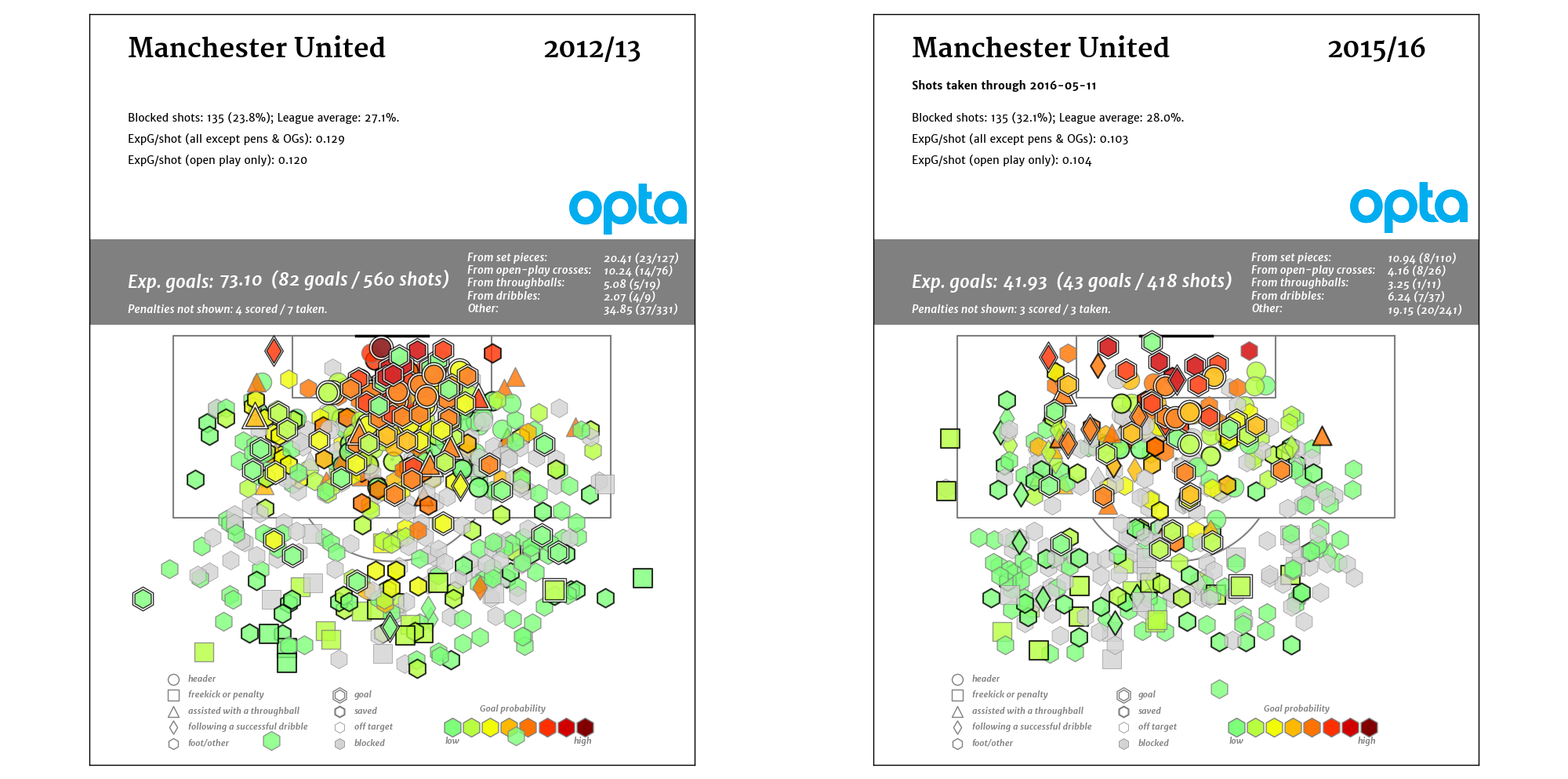
Woof.
25% fewer shots taken, which over the course of a season is 125-150 shots less. Quality of shot generated is also about 25% lower. Combine those two factors and you end up with a FORTY goal difference between the two years with one game left to play.
Fergie’s teams were amazing at generating central shots between the penalty spot on the goal. LVG’s are anything but, and that’s likely to cost them another Champions League campaign.
The players are good. Compare the squad to West Ham and Southampton, both of whom have scored more goals than United and have a better goal differential, and figure out which one you’d rather have.
United are losing out compared to title contenders in attack, and their players aren’t allowed to attack aggressively because how they defend doesn’t allow it. So to me, the problem is the tactical system they are playing, which is dictated by...
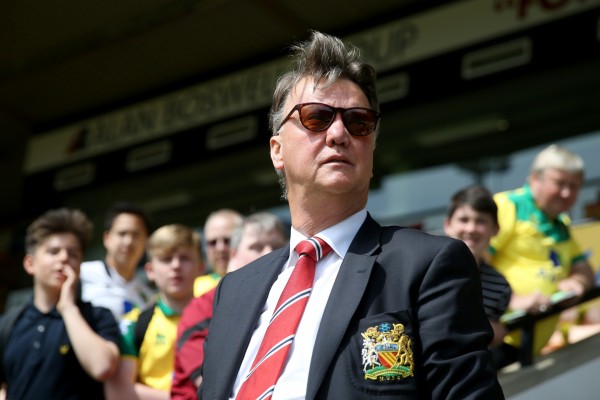
Non-United fans love van Gaal at least as much as David Moyes, which pretty much tells you everything you need to know about how good United have been under the former Dutch master.
Premier League 2015-16 Stat Round Up: Shots, Disappointing Giants And More
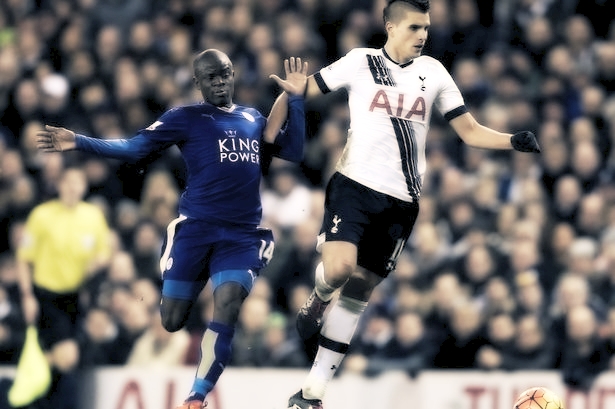 And so we reach the end of another season of “The Premier League”, the wildly popular and occasionally thrilling sporting serial transmitted to viewers around the world. The scriptwriters had work to do to improve on the 2014-15 season which in truth meandered at times, and boy did they deliver. Kindly, genteel Italian Claudio Ranieri returned from a long hiatus to take all the plaudits and in a delightful twist we waved farewell to familiar villain “JR” Mourinho, who once more got his comeuppance; an unforeseen and controversial plot this time found him failing to embrace feminism. Last year's entertaining entrant Louis van Gaal had a quieter run this time and the joke wore thin quickly for “Tactics” Tim Sherwood and Brendan Rodgers. Mauricio Pochettino brought some Argentinian grit in his second year at Tottenham and brooding Slaven Bilic brought intensity to the Hammers. Jurgen Klopp wore a dazzling smile throughout and was loved, and Roberto Martinez just smiled and was not. Nobody really knew who was managing Swansea and rather preposterously, another familiar face in Rafa Benitez taught Andros Townsend to shoot, for all the good that did. Killed off at the end of season 2014-15, Sam Allardyce was soon to make a lazarus-like return but the big story was what was organised in advance for the show's 2016-17 run. Superstar coach and all round hipster idol Pep Guardiola signed on for a big fee and expectation was tangible: could he build a team without centre backs to beat Tony Pulis' team of all centre backs? A ridiculous conceit surely, but when one is a fan of the Premier League, it's worth remembering, anything can happen, it already has and it won't again. Leicester that is. Roll on August. Shots
And so we reach the end of another season of “The Premier League”, the wildly popular and occasionally thrilling sporting serial transmitted to viewers around the world. The scriptwriters had work to do to improve on the 2014-15 season which in truth meandered at times, and boy did they deliver. Kindly, genteel Italian Claudio Ranieri returned from a long hiatus to take all the plaudits and in a delightful twist we waved farewell to familiar villain “JR” Mourinho, who once more got his comeuppance; an unforeseen and controversial plot this time found him failing to embrace feminism. Last year's entertaining entrant Louis van Gaal had a quieter run this time and the joke wore thin quickly for “Tactics” Tim Sherwood and Brendan Rodgers. Mauricio Pochettino brought some Argentinian grit in his second year at Tottenham and brooding Slaven Bilic brought intensity to the Hammers. Jurgen Klopp wore a dazzling smile throughout and was loved, and Roberto Martinez just smiled and was not. Nobody really knew who was managing Swansea and rather preposterously, another familiar face in Rafa Benitez taught Andros Townsend to shoot, for all the good that did. Killed off at the end of season 2014-15, Sam Allardyce was soon to make a lazarus-like return but the big story was what was organised in advance for the show's 2016-17 run. Superstar coach and all round hipster idol Pep Guardiola signed on for a big fee and expectation was tangible: could he build a team without centre backs to beat Tony Pulis' team of all centre backs? A ridiculous conceit surely, but when one is a fan of the Premier League, it's worth remembering, anything can happen, it already has and it won't again. Leicester that is. Roll on August. Shots 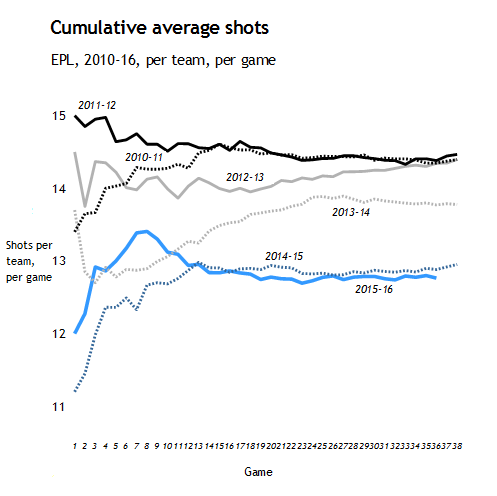 Last season we saw a significant drop in the shot volume in the league from the few seasons prior and the lower rate has continued into 2015-16, with a further though very slight decline. Over three shots per game have vanished from matches compared to the free and easy days of the early 2010s and it’s interesting to speculate why that might be. With our analytics hats on we might posit ideas around shot quality theories taking hold and we could cite Arsenal, particularly this season, as a team that focuses on this. Maybe the Dutch connection of Louis van Gaal and Ronald Koeman who preside over the 1st and 9th least shot-involved matches are influential here, or Mourinho, gone but with impact not forgotten? In truth it’s hard to know as if we look longer term these rates tend to oscillate up and down depending on fashion or styles. Where 2014-15 was a lull for both shots and conversions, 2015-16 has at least picked up in the latter:
Last season we saw a significant drop in the shot volume in the league from the few seasons prior and the lower rate has continued into 2015-16, with a further though very slight decline. Over three shots per game have vanished from matches compared to the free and easy days of the early 2010s and it’s interesting to speculate why that might be. With our analytics hats on we might posit ideas around shot quality theories taking hold and we could cite Arsenal, particularly this season, as a team that focuses on this. Maybe the Dutch connection of Louis van Gaal and Ronald Koeman who preside over the 1st and 9th least shot-involved matches are influential here, or Mourinho, gone but with impact not forgotten? In truth it’s hard to know as if we look longer term these rates tend to oscillate up and down depending on fashion or styles. Where 2014-15 was a lull for both shots and conversions, 2015-16 has at least picked up in the latter: 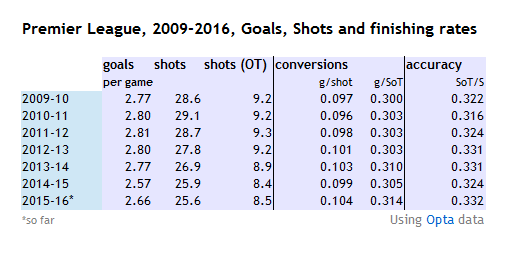 We can see that while goals and shot rates are at the low end, the rate in which shots or shots on target are being created is high when compared to the seven seasons nominated. Accuracy is also at the higher end too. Over the course of these seasons, wider perception of the quality of top Premier League teams has changed, the best sides in Europe are now seen to be elsewhere, so it’s interesting to note that across the whole league, there seems to be a slow but distinct trend towards teams becoming more efficient in their attacking play. Even with such broad strokes we can see an evolution and that Leicester, the ultimate low volume, high conversion team should triumph is a wry reflection of wider trends. Swansea and identifying the mean - or not While the Leicester story has mischievously run roughshod over most of the world of prediction and expectation--while offering mortgage paying joy for pub liars across the nation-- other teams have behaved almost entirely as expected, a case in point being Swansea. Across four previous seasons in the Premier League, Swansea have managed to become reliable performers; never worse than 12th and peaking with an 8th last year. This year they stared down the spectre of the bottom of the table before slowly righting themselves and now stand 13th, with anywhere from 11th to 15th seeming the most likely outcome. Bobby Gardiner dug deeper than most into them at the end of March and there isn’t too much to add but suffice to say, Swansea’s baseline has been almost identical throughout their time in the league:
We can see that while goals and shot rates are at the low end, the rate in which shots or shots on target are being created is high when compared to the seven seasons nominated. Accuracy is also at the higher end too. Over the course of these seasons, wider perception of the quality of top Premier League teams has changed, the best sides in Europe are now seen to be elsewhere, so it’s interesting to note that across the whole league, there seems to be a slow but distinct trend towards teams becoming more efficient in their attacking play. Even with such broad strokes we can see an evolution and that Leicester, the ultimate low volume, high conversion team should triumph is a wry reflection of wider trends. Swansea and identifying the mean - or not While the Leicester story has mischievously run roughshod over most of the world of prediction and expectation--while offering mortgage paying joy for pub liars across the nation-- other teams have behaved almost entirely as expected, a case in point being Swansea. Across four previous seasons in the Premier League, Swansea have managed to become reliable performers; never worse than 12th and peaking with an 8th last year. This year they stared down the spectre of the bottom of the table before slowly righting themselves and now stand 13th, with anywhere from 11th to 15th seeming the most likely outcome. Bobby Gardiner dug deeper than most into them at the end of March and there isn’t too much to add but suffice to say, Swansea’s baseline has been almost identical throughout their time in the league: 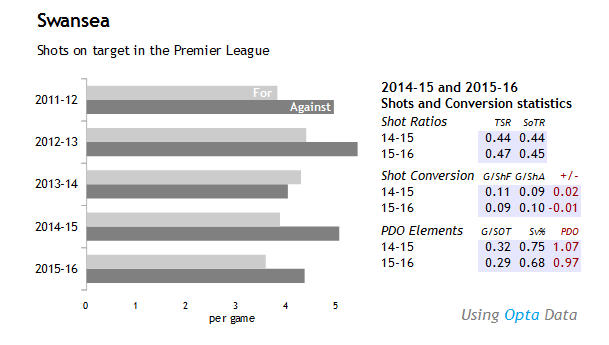 Some years, say 2014-15, they get a few more breaks than others and they look like they might be better than previously thought. On other occasions, namely this year, it takes time for them to get close to their true level-- around mid-table-- and all manner of chaos can ensue in between. As ever, unless managerial relationships have broken down entirely, which may well have been the case with Garry Monk, it’s probably smarter to play the long game and see how it pans out. That they have created a halfway house with the appointment of first Alan Curtis and then Francesco Guidolin at least allows some room to make a bigger decision in the summer, if required. The real point here is broader. Sometimes it’s reasonably straightforward to predict long term movement for a club when you have access to performance statistics, be they expected goals, shot numbers or more. In this case, Swansea’s 8th in 2014-15 caused positive reflection, raised expectations and may well have contributed to the reaction from the board in removing Monk, when in fact, this last autumn they were simply going through a period of reversion, to a pretty long term and solid mean. Identifying such a mean is a problem that continues to test analytical practitioners and gamblers and we have a few teams this season that may provide a larger challenge than is often the case. Various shot metrics and expected goals peg Leicester as around the 4th or 5th best team in the league, and while fortune has beamed widely upon them in the shape of injuries, penalties and periodic conversion rates, it’s also true that they look to have improved as time has gone on. A broad analysis of their entire season would show one level when a trajectory will slightly differ; this season’s Champions must be good, right? Well, up to a point yes, but with few confident of their future likely performance levels, beyond the idea that they will fall off to some degree, it’s hard to get a clear idea of where they might end up, or indeed what their true talent level is. Claudio Ranieri, refreshingly seems happy to once more play down expectations and should be respected for doing so, even if it’s just part of his schtick. See also West Ham. Very similarly to Leicester they have spent much of the year defying their sub-par shooting and expected goal figures. With a new coach in Bilic and a slow move towards improvement as the season has gone on, we are once more left pondering which aspects of their performances are likely to prove repeatable, and which could be remedied or stymied by personnel changes or simple skews. I make West Ham three season overachievers on their defensive end and the quandary here is do we give credit to Sam Allardyce and his methods and accept a skew this year, or do we assume in a league of twenty teams, that at least one team will at any one time be experiencing a skew lasting this long at any given time? We know little about Bilic’s methods to be able to make strong measurements and gauge his influence, but maybe he is adept in similar ways to Allardyce? It can't be ruled out. Interestingly Johannes Harkins placed these two in the same group in an analysis he performed last week on the Optapro blog and they currently share both style and over performance, and the question going forward remains how much or if even these things are interlinked. Arsenal, Manchester City and Chelsea Also notable in that analysis were the co-grouping of the three traditional giants of the modern league: Arsenal, Manchester City and Chelsea. All good passing teams, generally decent at controlling play and (usually) dominating shot counts yet each has firmly underperformed expectations this year, and in different ways. Arsenal’s external mean seems to find them landing 3rd or 4th in any league they compete in and that they haven’t managed to challenge longer and harder for the title can largely be attributed to struggling to match expectation at home. In winning only 11 of 18 homes games so far, and scoring only the 9th most goals in the league in their home stadium, the problem here has been clear. Both expected goals and shot analysis show their attack has left a ton of goals behind there and while their defence has been fine at home and their results have more obviously matched their metrics away from home, the Emirates is where it’s gone awry. The latter half of the season, Santi Cazorla apart, has not even been affected by a typical injury malaise. They got largely fit and then since beating Leicester on Valentine’s Day have gone 4-5-2. Perplexing stuff. So it’s still hard to peg Arsenal’s true level: same as they ever were or foiled by a cold streak? Manchester City have oddly continued to underhit against their strong shooting numbers and with an aging squad and a lame duck coach, only the Champions League run has kept the season alive, until now. Their defence is in line to concede the fewest shots per game in the Enlightened Era (2009-10 onwards) yet it feels as though Alexis Sanchez’s equaliser this last Sunday was all too representative of the shots and goals they have conceded; the back line shredded and concession all too easy. Again, like Arsenal they have failed to win seven home games--far too many for Championship contenders-- and in losing five times at the Etihad, they match the home loss record of Swansea and Newcastle. All the while expected goals only prefers Arsenal and shot metrics prefer Tottenham, they are not a bad team but are currently facing down a potential 5th place; that's a skew downwards about as large as Leicester has up. Baffling stuff. It’s highly probable that Pep Guardiola has a little more to work with in his squad than current perception suggests, but further large transfer investment, with little opportunity to sell, seems inevitable. Surely their trajectory must be up? And Chelsea, who careered through the autumn with declining performances and acted too late in removing Jose Mourinho to save their season. On the ball they still look like they could be a decent side, but even a generous expected goals model will struggle to value them above seventh or eighth and their shots numbers are no better than par. Guus Hiddink has had a nice run of balancing out his team’s conversion rates but they look to be a reasonable distance away from a title shot and even top four may be a tricky task next year. Antonio Conte, much like Guardiola, is sure to want new recruits to galvanise his squad and the spine of 2014-15, so strong in the early part of that title winning season, looked to have slipped a disc this time round. Maybe Eden Hazard will stick around and build upon the flashes of form we are now seeing, his injuries behind him? Regardless, if any team can benefit from the “No Europe” skew, then it’s Chelsea, but they will have to improve on their baseline, for during 2015-16 there simply wasn’t enough there. Newcastle’s Transfer Window Trophy wasn’t enough Newcastle vs Villa had a fascinating shape from a shots perspective. With a combined 11 shots, only the strange nine shot 1-1 draw between Bournemouth and Leicester back in August has had fewer this season. In isolation, Newcastle’s limitation of of Villa to two shots in total is admirable but it seems as if Rafa Benitez’s natural pragmatism may well have finally cost his team a place in the league. The Match of the Day analysis from Ian Wright noted simply how Newcastle were offering no pressure to Villa in possession and you can’t escape the fact that Newcastle absolutely had to win this game, given it was against the league’s clear worst team and they face Tottenham to finish. By ensuring that not getting beaten was his team’s primary aim, Benitez clearly offered Villa too much respect. Since joining the club, it seems clear that he has focused on reducing events within the game. The last nine games of Steve McClaren’s reign featured roughly 26 shots per game (across both teams) and under Benitez that has dropped to around 21. But why? What has this achieved? Not a lot. McClaren had tangibly improved Newcastle from Christmas onwards, albeit from a horrifically low base, but was getting annihilated in the shot conversions. Benitez has supervised a zero goal difference but has taken away three shots a game from his attack over these periods and where McClaren posted a differential of +7 shots on target in those 9 games, Benitez is basically the same with +8. Can we identify a slight increase in efficiency? Maybe. Expected goals suggest a little but probably without effecting enough real progress to save them. Two wins hasn’t been enough and Newcastle aren’t a good team. Their squad looks to have been bought erratically and while they have talent in among their individuals, there are weaknesses throughout. They spent a fortune in January and it looks like it will be to no avail but regardless, if you’re playing Villa, you must be looking to create more than nine shots in a game. Volume will always have a huge importance, and it seems Benitez and Newcastle are going to find out to their cost that you need to do more than try and edge games against the league’s bottom team. What else? (and apologies to any omitted teams)
Some years, say 2014-15, they get a few more breaks than others and they look like they might be better than previously thought. On other occasions, namely this year, it takes time for them to get close to their true level-- around mid-table-- and all manner of chaos can ensue in between. As ever, unless managerial relationships have broken down entirely, which may well have been the case with Garry Monk, it’s probably smarter to play the long game and see how it pans out. That they have created a halfway house with the appointment of first Alan Curtis and then Francesco Guidolin at least allows some room to make a bigger decision in the summer, if required. The real point here is broader. Sometimes it’s reasonably straightforward to predict long term movement for a club when you have access to performance statistics, be they expected goals, shot numbers or more. In this case, Swansea’s 8th in 2014-15 caused positive reflection, raised expectations and may well have contributed to the reaction from the board in removing Monk, when in fact, this last autumn they were simply going through a period of reversion, to a pretty long term and solid mean. Identifying such a mean is a problem that continues to test analytical practitioners and gamblers and we have a few teams this season that may provide a larger challenge than is often the case. Various shot metrics and expected goals peg Leicester as around the 4th or 5th best team in the league, and while fortune has beamed widely upon them in the shape of injuries, penalties and periodic conversion rates, it’s also true that they look to have improved as time has gone on. A broad analysis of their entire season would show one level when a trajectory will slightly differ; this season’s Champions must be good, right? Well, up to a point yes, but with few confident of their future likely performance levels, beyond the idea that they will fall off to some degree, it’s hard to get a clear idea of where they might end up, or indeed what their true talent level is. Claudio Ranieri, refreshingly seems happy to once more play down expectations and should be respected for doing so, even if it’s just part of his schtick. See also West Ham. Very similarly to Leicester they have spent much of the year defying their sub-par shooting and expected goal figures. With a new coach in Bilic and a slow move towards improvement as the season has gone on, we are once more left pondering which aspects of their performances are likely to prove repeatable, and which could be remedied or stymied by personnel changes or simple skews. I make West Ham three season overachievers on their defensive end and the quandary here is do we give credit to Sam Allardyce and his methods and accept a skew this year, or do we assume in a league of twenty teams, that at least one team will at any one time be experiencing a skew lasting this long at any given time? We know little about Bilic’s methods to be able to make strong measurements and gauge his influence, but maybe he is adept in similar ways to Allardyce? It can't be ruled out. Interestingly Johannes Harkins placed these two in the same group in an analysis he performed last week on the Optapro blog and they currently share both style and over performance, and the question going forward remains how much or if even these things are interlinked. Arsenal, Manchester City and Chelsea Also notable in that analysis were the co-grouping of the three traditional giants of the modern league: Arsenal, Manchester City and Chelsea. All good passing teams, generally decent at controlling play and (usually) dominating shot counts yet each has firmly underperformed expectations this year, and in different ways. Arsenal’s external mean seems to find them landing 3rd or 4th in any league they compete in and that they haven’t managed to challenge longer and harder for the title can largely be attributed to struggling to match expectation at home. In winning only 11 of 18 homes games so far, and scoring only the 9th most goals in the league in their home stadium, the problem here has been clear. Both expected goals and shot analysis show their attack has left a ton of goals behind there and while their defence has been fine at home and their results have more obviously matched their metrics away from home, the Emirates is where it’s gone awry. The latter half of the season, Santi Cazorla apart, has not even been affected by a typical injury malaise. They got largely fit and then since beating Leicester on Valentine’s Day have gone 4-5-2. Perplexing stuff. So it’s still hard to peg Arsenal’s true level: same as they ever were or foiled by a cold streak? Manchester City have oddly continued to underhit against their strong shooting numbers and with an aging squad and a lame duck coach, only the Champions League run has kept the season alive, until now. Their defence is in line to concede the fewest shots per game in the Enlightened Era (2009-10 onwards) yet it feels as though Alexis Sanchez’s equaliser this last Sunday was all too representative of the shots and goals they have conceded; the back line shredded and concession all too easy. Again, like Arsenal they have failed to win seven home games--far too many for Championship contenders-- and in losing five times at the Etihad, they match the home loss record of Swansea and Newcastle. All the while expected goals only prefers Arsenal and shot metrics prefer Tottenham, they are not a bad team but are currently facing down a potential 5th place; that's a skew downwards about as large as Leicester has up. Baffling stuff. It’s highly probable that Pep Guardiola has a little more to work with in his squad than current perception suggests, but further large transfer investment, with little opportunity to sell, seems inevitable. Surely their trajectory must be up? And Chelsea, who careered through the autumn with declining performances and acted too late in removing Jose Mourinho to save their season. On the ball they still look like they could be a decent side, but even a generous expected goals model will struggle to value them above seventh or eighth and their shots numbers are no better than par. Guus Hiddink has had a nice run of balancing out his team’s conversion rates but they look to be a reasonable distance away from a title shot and even top four may be a tricky task next year. Antonio Conte, much like Guardiola, is sure to want new recruits to galvanise his squad and the spine of 2014-15, so strong in the early part of that title winning season, looked to have slipped a disc this time round. Maybe Eden Hazard will stick around and build upon the flashes of form we are now seeing, his injuries behind him? Regardless, if any team can benefit from the “No Europe” skew, then it’s Chelsea, but they will have to improve on their baseline, for during 2015-16 there simply wasn’t enough there. Newcastle’s Transfer Window Trophy wasn’t enough Newcastle vs Villa had a fascinating shape from a shots perspective. With a combined 11 shots, only the strange nine shot 1-1 draw between Bournemouth and Leicester back in August has had fewer this season. In isolation, Newcastle’s limitation of of Villa to two shots in total is admirable but it seems as if Rafa Benitez’s natural pragmatism may well have finally cost his team a place in the league. The Match of the Day analysis from Ian Wright noted simply how Newcastle were offering no pressure to Villa in possession and you can’t escape the fact that Newcastle absolutely had to win this game, given it was against the league’s clear worst team and they face Tottenham to finish. By ensuring that not getting beaten was his team’s primary aim, Benitez clearly offered Villa too much respect. Since joining the club, it seems clear that he has focused on reducing events within the game. The last nine games of Steve McClaren’s reign featured roughly 26 shots per game (across both teams) and under Benitez that has dropped to around 21. But why? What has this achieved? Not a lot. McClaren had tangibly improved Newcastle from Christmas onwards, albeit from a horrifically low base, but was getting annihilated in the shot conversions. Benitez has supervised a zero goal difference but has taken away three shots a game from his attack over these periods and where McClaren posted a differential of +7 shots on target in those 9 games, Benitez is basically the same with +8. Can we identify a slight increase in efficiency? Maybe. Expected goals suggest a little but probably without effecting enough real progress to save them. Two wins hasn’t been enough and Newcastle aren’t a good team. Their squad looks to have been bought erratically and while they have talent in among their individuals, there are weaknesses throughout. They spent a fortune in January and it looks like it will be to no avail but regardless, if you’re playing Villa, you must be looking to create more than nine shots in a game. Volume will always have a huge importance, and it seems Benitez and Newcastle are going to find out to their cost that you need to do more than try and edge games against the league’s bottom team. What else? (and apologies to any omitted teams)
- Manchester United continue to be straitjacketed by Louis van Gaal’s methods, yet could find an unlikely late run into the Champions League, Expected goals or shots don’t paint a kind picture (7th-8th) yet they remain in the hunt, and should they win the FA Cup or land in the top four, it’s going to take a brave man to tell Louis to go away.
- Southampton’s solid rise continues. They’ve now had four years of extremely competitive defensive numbers and have consistently failed to miss their departing stars. The Team Most Likely To Get Among The Big Boys title may have been handed on to Leicester for now, but i’d happily bet that they will be in the mix for the European spots once more next year.
- Stoke rode their numbers for half a season, were extremely erratic and then had spells of utter dreadfulness from there on in. It’s hard to think that Mark Hughes has taken them forward and beyond the fact that they’ve never been in any serious trouble this year, it’s been largely forgettable.
- Liverpool might end up in the Champions League yet if they do not will surely rue that they did not collect a handful more points and pressurise the top four. If this Manchester United team can go into the final week of the season still in contention, that Liverpool are not is a poor reflection. At times they have been irresistible--everything except their save percentage and the resulting goals against look like a top four team-- at times entirely baffling, but that their near future rests on a pivotal coin flip of a cup final against the owners of the Europa League is a fascinating gambit.
- Everton have had a curate’s egg of a season, the metrics say they’re okay, as in mid-table, but the post Christmas malaise has been entirely poisonous and it looks as though Martinez’s position has become untenable. The weirdly timed signing of Oumar Niasse continues to baffle and bringing in an attacking reinforcement when their defence needed help seemed ill advised. Farhad Moshiri looks on, and one wonders how much influence he will have going forward. Everton do have talent in their squad, it feels like rigour may be needed to harness it.
- Aston Villa are in clear contention for having created the worst Premier League season of the decade and I use that cut off to spare them comparisons to the legendarily bad Derby 2007-08 team. In particular their attack has been utterly bereft of quality and their rate of shots on target per game (2.9) now interrupts a three season Tony Pulis Stoke City salvo at the very bottom of the seven season chart. They have also conceded all shots at a rate (14.9%) only superceded oddly by Bournemouth this year (15.1%) across the same period.
Obligatory Tottenham Finale It would be remiss of me to finish without at least giving a few words to Tottenham. Benefitting from the vague ineptitude of the larger teams in the league and finding the top four would have been a great achievement in any other season, but to do so as a dominant team bouncing forward from the weird chaotic systems of 2014-15 has been fascinating to see. Second or third place are secure, meaning the Champions League, and while Tottenham are well built for European competition, it’s refreshing to feel that the upgrading required is mainly in the squad. With a fit first 11 to rival any team in the land, it seems highly likely that they will be able to build on this season’s fine efforts in the coming years. Shooting metrics loved them, expected goals loved their defence and volume was their biggest friend throughout at both ends. Too many draws, rather flat conversion rates driven by ranged shooting and Richard the Third’s malign influence finished their title bid but coherence was finally achieved and they even learned to fight when things didn’t go their way. In among the metrics of small concern, both they and Leicester managed to create shots on target and prevent the opposition at historically super high rates: they rank 1st and 3rd here over the last seven seasons and it's a measure that is prone to regression. When you see them in and around Liverpool 2013-14, Chelsea 2014-15 and Manchester United 2012-13, all teams that fell dramatically out of the top two after skewing positively here, it's worth noting. Unlike these teams and Leicester though, Tottenham had no attacking boost in their shot conversion, so are perhaps better set to maintain than some of those mentioned. Player wise it was all good: Harry Kane continued to score, Christian Eriksen kept them ticking over and it’s been many, many months since a “waste of money” Erik Lamela article. All the while Eric Dier and Dele Alli found love in the midfield, Mousa Dembélé showed that his skills are entirely unique and useful, Danny Rose came of age, Kyle Walker reminded us how he won a Young Player of the Year Award, Toby Alderweireld and Jan Vertonghen remained steady and largely impenetrable and Hugo Lloris stayed on his line. Between Tottenham and Leicester, it was hard to find a first team starter that had disappointed this year. It’s been a good one. ______________________________________________________________________________ (This season wrap is a week early because i'm going on holiday, so you either got this now or nothing 🙂 ) Thanks to everyone who has read this column this season and before, to all who have shared it, promoted it, criticised it or ignored it: it's always fun to write. Meanwhile, here at StatsBomb we will aim to continue to bring you quality content from the smartest analytical writers over the summer, so keep checking back. The season may end but there are always new angles to pursue and stories to tell. Find me on twitter @jair1970
The Death of Traditional Scouting
Note: This was originally given as a presentation at the Science + Football conference in May 2016. After a great many requests, it has been lazily converted into the article below.
In the beginning… Cavemen scouts watched cavemen footballers live and in the flesh.
Then… Cavemen invented television, and cavemen scouts could watch cavemen footballers on video.
Now… Cavemen have invented computers. And spreadsheets. And air conditioning. New, useful tools in evaluating cavemen footballers in a search for the best, brightest, and undervalued.
What Did Video Bring To Scouting?
- It’s cheaper. Look at a year of video provider service (like WyScout or Instat) compared to a year of travel budget to put scouts at live matches.
- Scouts now have easy access to more players and leagues than ever before.
- Finally, and most importantly… it’s all on demand. Whenever your scouts need to watch footage of players, they can. No more of this waiting for actual football to be played in front of you while you sit in cold, rainy stands on a Tuesday in Stoke nonsense.
What Does Data Bring to Scouting?
- Instead of evaluating hundreds of players a year, you can profile tens of thousands.
- Of those players, you get every minute played and every event they were involved in.
- Once the infrastructure is created, costs are whatever your data costs are.
- DIFFERENT, OBJECTIVE DATA than traditional scouting reports.
Plenty of people talk about the “data revolution” in sports. For me, it’s just another step and another set of tools to use in the evolving recruitment landscape.
How Does It Work Inside a Club?
With a small recruitment team of 2 stats + 6 part-time scouts, we evaluated over 1000 players in a year for the first teams of Brentford and Midtjylland.
Yes, but were you successful?
This is the most important factor, and obviously it depends on how you look at it. After a disastrous start in the first 9 games due to a poor manager choice, Brentford earned points at nearly a playoff pace, despite awful injuries in the first half of the season. The team also lead the league in goals scored and avoided an FFP-related transfer embargo.
And most importantly, they did it with one of the lowest wage budgets in the league and a £10-11m transfer fee surplus* in the year we were involved in recruitment. I’m going to notch that up as success, while admitting that at the start of the season, I was hoping for promotion just like the owner and every other Brentford fan out there.
*My estimate, not gospel truth.
Not Scouting Players Live is Ridiculous!
I get this sentiment a lot, both from fans and even from smart people who work inside of football. My perspective is like this
- By not spending time and money sending scouts to watch (many) live matches, we are able to watch a much greater volume of matches and more players. Travel time is a resource cost and it can be significant.
- Also by not sending scouts to watch live matches, we cut out an enormous source of cognitive bias.
Take this quote for example: “I can learn more about a player in 20 minutes in the stands than I can by watching him in hours of video footage.”
For this to be true, you either have to be some magical savant of player evaluation or you are full of shit. Conservatively, I would say 99% of people who feel this way have to be the latter.
This is a HUGE problem when it comes to scouting. If 4-5 games worth of video scouting work can be wiped away by sending one guy to the stadium, your process has a huge flaw, and likely so does your scout. It’s a correctable flaw, but if this type of thing is what decides whether you sign a player or not, good luck to you.
Yes, you need information about what the player is like with their coaches and teammates. That’s what personality profiles and background checks are for. Thinking you can get all of that information based on seeing a player once or twice in person is a myth the scouting world has sold itself.
Do I think there is potential value in watching certain positions live? Yes.
And some leagues have no useable video, so old-fashioned, in-person scouting is the only way to get the job done. In general though, I would do as much video work as possible in any club that I work in for the reasons explained above.
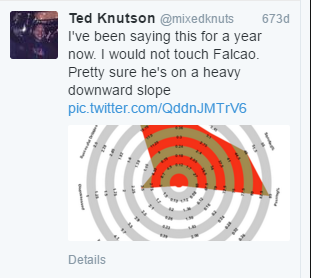
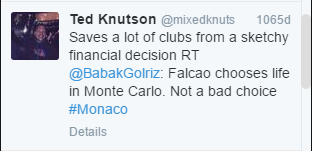
The Story of Radamel Falcao
And all of this was above and beyond the ACL injury, which for a 28 year old striker is a real concern. Loan fee: Unknown (Rumored to be 5-10M a season) Wages: Massive (Rumoured to be 13M+ a season) Outcome: 4 goals and 4 Assists at Manchester United. 1 Goal, 0 assists at Chelsea.
Lesson: Even if the ONLY THING adding data to your recruitment does is save you from a couple of bad decisions every year, they still pay for themselves. (In this case by saving something like 20M in wasted money on Falcao.)
Nate Silver and PECOTA
- PECOTA = Statistical scouting system for baseball.
- It was a very good system for evaluating Major League talent at the time.
- In 2006, Silver started applying it to minor league prospects. At that time, the only competition was from the scouts.
- In 2011, he compared PECOTA projections to the scouts…
- Scout forecasts were 15% better than PECOTA’s predictions, resulting in $+336M worth of extra wins during that period.
Reasoning behind this was two-fold. First, the scouts started to use basic numbers more to inform their scouting. Second, scouts have far more than just statistics at their fingers to evaluate prospects. They know whether guys are smart. Or overweight. Or hard working. Or any number of other things PECOTA did not know.
Nate’s conclusion: “The only way a purely stat-based list should be able to beat a hybrid list is if the biases introduced by the [scouting] process are so strong that they overwhelm the benefit.”
Building a Hybrid Process
- Names come in from any source – agents, coaches, players, scouts, numbers… whatever
- Initial check on Age/Passport/Realism/Need
- Stats check in leagues where you have stats – initial quick video scout in leagues where you don’t
- If players pass that, they go into the proper scouting queue. The player also triggers a detailed stat check.
- Scouting report comes back. Combined recruitment group ranks players for positions based on clear guidelines from head coach.
- List with executive summaries + video delivered to coaches.
Scouting Biases
What follow are actual quotes from scouts I have collated by networking with other football people for the last couple of years.
- “Six months in the devs and maybe he’ll be good enough.” This player went on to a big 5 move after being voted best player in his league
- “Poor tackler.” This player lead his league in tackling.
- “Couldn’t play in a midfield 2.” This player was the best DM in his league the year before. Then he was the best AM in his league the next season.
- “Plays in a shit league.” Quants have solid algorithms that tell which leagues are good/bad. This league was actually solid.
- “Few Shots. Snatches at the ball. Not a finisher.” Finished with an NPG90 of .9 for the season, and shots90 above 4. Whatever he was doing seemed to put the ball in the back of the net a surprising amount.
- “Not enough heart for a [REDACTED] player.” Sadly, we have no algorithm that directly measures heart. Also, I’m not sure how you argue back about this in a recruitment meeting without being extremely sarcastic. Thankfully, I wasn't involved.
So if this is the general environment you are walking into, what do you do?
Profile Your Scouts
- Scouting reports are DATA! Data is meant to be analysed.
- Go back through past work and review it.
- If using numbers, what are the average scores for each scout? For each position? What if some scouts never find a centerback or fullback that is deemed good enough to play in your team? You need to know that and adjust for it.
Are they biased:
- Toward young players?
- Against foreigners?
- Just don’t understand the football in certain leagues? If the style of football in certain leagues differs a lot from what a scout is used to, they can have problems evaluating players in those leagues.
Data analysis is complicated and hard. Scouting is also complicated and hard, but uses an entirely different set of skills. One club I know of has scouts in 37 different countries, speaking more than 10 different native languages. Standarizing output across that organization simply based on linguistic differences is nearly impossible.
Standardize Your Scouts
- Scouts are not just plug and play. Scouting is hard work and scouts from different clubs and backgrounds might be looking for totally different things in players than your club requires.
- Scouts need training, and clear guidelines on what to look for when evaluating players.
- Scouts may need training across multiple leagues and styles of football.
- Youth scouts need even MORE guidance, since there are a ton of pitfalls regarding relative age and growth spurts they need to work around.
Lesson: You need to standardize traditional scouting output as much as possible to make better decisions and so that even your scouting output is consistent.
Conclusions
- Increased use of stats and data is just a part of the long-term evolution of the recruitment landscape.
- Talented scouts are hard to find and will remain extremely valuable members of any club.
- Hybrid processes – both stats and traditional scouting - are mandatory as best practice.
- On-demand video and data allow teams to use these valuable scouting resources more effectively.
- You MUST be aware of scouting biases in order to get the most out of these valuable employees.
Ted Knutson @mixedknuts mixedknuts@gmail.com
Bournemouth: So Far So Good, But Room For Improvement?
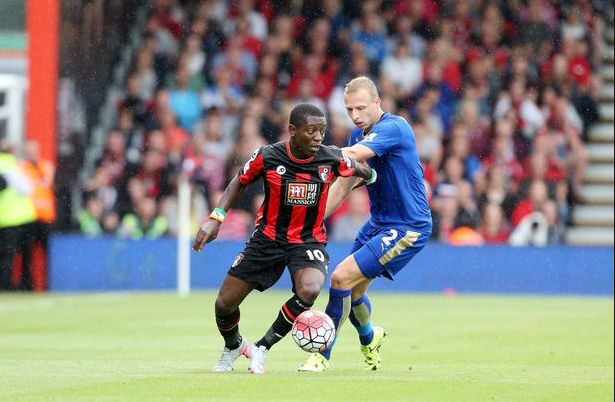 Very much like Watford, Bournemouth are executing the perfect 1st season in the Premier League. Pre-season they were listed as 6/4 odds to get relegated yet they're comfortably above the relegation scrap. Their season has included a memorable victories against Chelsea and Manchester United but severe knee injuries limited their attacking stable and they have still scraped together 41 points as a debut PL side, which is actually pretty impressive all things considered. It was interesting to see how much pragmatism Bournemouth would have to adopt as they got adjusted to a higher level of competition, seeing as they came with the reputation of having been one of the most attractive Championship sides in years. It's kind of a shame that we were robbed of a full season of Max Gradel and Callum Wilson together. Gradel was one of the five best players in Ligue 1 last season, almost a one man offense for Saint Etienne as a half space winger. His speed is terrifying and you could've easily seen his type of play translate well into the Premier League. Against West Ham, the duo were impressive and even though all of the four goals for Bournemouth involved shocking defending you could imagine what a full season with those two would've added to their club, especially given how most teams in the PL can be susceptible to counter attacking football. Without those two for the majority of the season, most of what made Bournemouth successful hasn't changed from what made them successful last season in the Championship, but the extra quality that would make these type of counter attacks more potent have ended up like this: https://streamable.com/gxb9 https://streamable.com/vqee You'll notice a trend here going forward, because a decent amount Bournemouth's issues can be described by a broad talent deficiency at this level. This isn't any shock, seeing as the jump from the Championship to the Premier League has proven too much for many promoted teams. A lot of their build up play does lead up to throughball opportunities which is a good profile to follow, but understandably the back-ups to Wilson or Gradel aren't of the same quality. This could be seen with their shot profile. Despite some focus on the creation of high quality shots, more than 50% of Bournemouth's shots this season have come from outside the area This is how it looks for their shots on target.
Very much like Watford, Bournemouth are executing the perfect 1st season in the Premier League. Pre-season they were listed as 6/4 odds to get relegated yet they're comfortably above the relegation scrap. Their season has included a memorable victories against Chelsea and Manchester United but severe knee injuries limited their attacking stable and they have still scraped together 41 points as a debut PL side, which is actually pretty impressive all things considered. It was interesting to see how much pragmatism Bournemouth would have to adopt as they got adjusted to a higher level of competition, seeing as they came with the reputation of having been one of the most attractive Championship sides in years. It's kind of a shame that we were robbed of a full season of Max Gradel and Callum Wilson together. Gradel was one of the five best players in Ligue 1 last season, almost a one man offense for Saint Etienne as a half space winger. His speed is terrifying and you could've easily seen his type of play translate well into the Premier League. Against West Ham, the duo were impressive and even though all of the four goals for Bournemouth involved shocking defending you could imagine what a full season with those two would've added to their club, especially given how most teams in the PL can be susceptible to counter attacking football. Without those two for the majority of the season, most of what made Bournemouth successful hasn't changed from what made them successful last season in the Championship, but the extra quality that would make these type of counter attacks more potent have ended up like this: https://streamable.com/gxb9 https://streamable.com/vqee You'll notice a trend here going forward, because a decent amount Bournemouth's issues can be described by a broad talent deficiency at this level. This isn't any shock, seeing as the jump from the Championship to the Premier League has proven too much for many promoted teams. A lot of their build up play does lead up to throughball opportunities which is a good profile to follow, but understandably the back-ups to Wilson or Gradel aren't of the same quality. This could be seen with their shot profile. Despite some focus on the creation of high quality shots, more than 50% of Bournemouth's shots this season have come from outside the area This is how it looks for their shots on target. 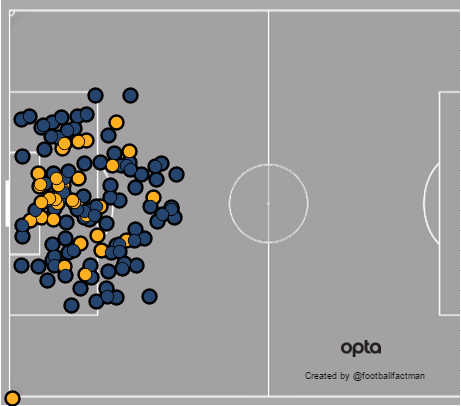
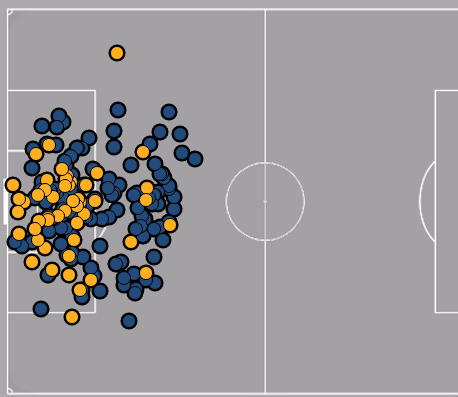
| Team | TSR | SoTR | xGR | SH% | SV% |
| Swansea 11-12 | 44.1 | 43.7 | .410 | 30.3 | 72.7 |
| Southampton 12-13 | 53.3 | 51.2 | .502 | 29.3 | 62.3 |
| Bournemouth 15-16 | 51.6 | 50.0 | .450 | 30.2 | 56.2 |
There's two paths that Bournemouth can take as a club. Swansea have been somewhere between average and below average over the past 5 seasons and variance until this season had kept them 8th-12th. Meanwhile until Leicester gathered up all the fairy dust known to man, Southampton had become the new model club that's kept pushing the boundaries on how far they could contend and seemed genuine 4th place contenders, if only things fell right. We could even see the progression offensively from Southampton with multiple seasons of aggregating talent and solidifying their foothold as a stable Premier League club allowing them to become better in their shot selection while still having the volume from previous years. 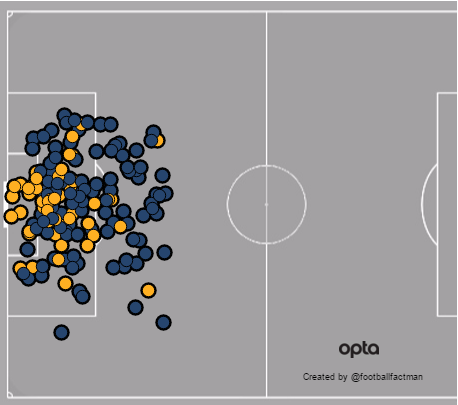
Set-piece routines have somewhat untapped potential. Bournemouth use them well though. pic.twitter.com/3vZ4FCGvjY
— JD (@JudahDavies) April 10, 2016
The end results haven't actually been that good, their goal% in these situations is 6th worst at 41.7%. But the fact that they're cognisant of the potential benefits is positive. Clubs of Bournemouth's size have to take advantage of these types of inefficiencies. Bolton with Sam Allardyce did it to the extreme a generation ago and they were a huge success. I wouldn't expect Bournemouth to go to nearly the same degree as Big Sam did because football has evolved but a few extra goals here and there from exploiting obvious inefficiencies is a smart focus. Most of the time when a team have a low save percentage, the first instinct is to say that it's unlucky. There's been research done during the very beginnings of the analytics movement in football that showed save percentage year by year is close to unrepeatable. If people looked at Liverpool's rate, they'd say that they've been pretty unlucky this season. Naturally similar things would be said about Bournemouth when one takes into account that theirs is actually considerably worse. But similar to Aston Villa, when this trend repeats itself for 3-4 years, the noisy nature of save percentage can start sussing out. Case in point, every season that Artur Boruc has been the starting goalie his team has had a very low save%, and he was on Southampton who were good-very good defensively. Paul Riley's expected goal model has rated Boruc poorly ever since his debut Premier League debut four years ago, and his shot stopping rating of 0.78 this season is 2nd worst for keepers that have faced at least 75 shots on target. If you want to see the benefits of high shot stopping rates look at West Ham this season or Swansea last season, teams that have pumped up 4-5 spots up on their true talent level cause of favorable variance. I know it's not exactly the most strident analytical take, but anyone who plays some form of organized football must know the feeling when you need just one save to get you out of trouble and the keeper can't get it. That's the type of hell Bournemouth have been stuck in this season. It also doesn't help when that hell include gaffs like this: https://streamable.com/je4l Their goalkeeping problem is compounded even further because even though Bournemouth are okay at suppressing shots, ranking 5th in shots conceded and 7th in shots on target conceded, they give a ton of big chances with only Norwich haven given up more this season. Some of them in particular have been blatantly bad: https://streamable.com/85ox https://streamable.com/v22u Bournemouth have the worst shot quality per shot on target conceded in the Premier League this season, just barely worse than Norwich. That's right, even Aston Villa aren't conceding such easy opportunities. This has been even more pertinent in games against tougher competition. Spurs and Man City have scored 17 goals in their four matches against them, Arsenal created six Big Chances in their first meeting in December, hell they let West Ham score six goals combined in their two fixtures. It's been obvious that as soon as Bournemouth play someone that's anywhere close to the level of the established elite, they leak goals. So if we've just spent nearly 1000 words on the weaknesses of Bournemouth, why are they so interesting? Well it comes down to the old adage of "process over results". Some results have been bad and although gaining points at the hand of rivals has proven successful, if it wasn't for the complete incompetence of Villa/Newcastle/Norwich/Sunderland, Bournemouth would probably be much closer to relegation than they currently are. But the actual process behind all of this is surprisingly sound. There has been tactical analysis done on Bournemouth previously, both on the ball and off it. It looks like there's a relatively deep complexity to how everything is done, even hinting at the now famed Positional play. Obviously we've watched more of the deficiencies than we have their strengths and those articles both warned that there would be growing pains but it is encouraging that behind all of the carnage displayed is discernible method. That being said, it's easy to say that just upgrading the talent will solve these problems but getting the talent in of itself is an arduous task. One of the problems that Bournemouth face is just how rigid the Premier League can be for a club like them. Leicester are a freak and shouldn't seen as some way to climb up the table. Building for the long term is in their best interest, but thinking of it as a linear progression would be sugar coating it because despite the TV money making it more easier for smaller clubs to keep their own players, it's still hard to convince them that Bournemouth aren't a stepping stone club unless they make the leap like Southampton did. This isn't to entirely demean what Bournemouth currently have because they do have some quality players, including Junior Stanislas. If they ran it back next season with more or less the same roster but have Gradel/Wilson healthy, they should have enough to finish 14th-15th again, with a view to progress down the line. As a team battling against the odds, smart recruitment is an area in which they may be able to secure an edge and should be exploited. Bournemouth are in the early days of their PL expedition and they've already accomplished step one of a multistep plan, which was to avoid relegation and keep collecting the TV money that will become even more valuable with the new deal kicking in next season. Some of their peripheral numbers seem pretty decent despite the mass amount of injuries in addition to it being their first season in the top division. The actual quality of football hasn't been as awe inspiring as it was last year because of a jump in competition, but there's a framework for something grander. Talent more or less wins out and Bournemouth may have a tough time retaining their better players and attracting more, but if they can do that there is the blueprint for perhaps the next Southampton to emerge.

